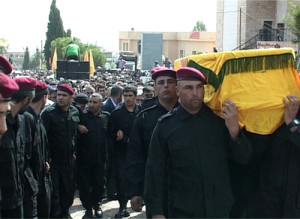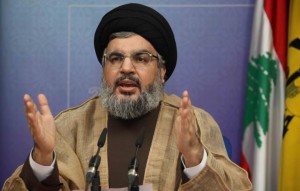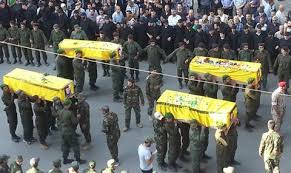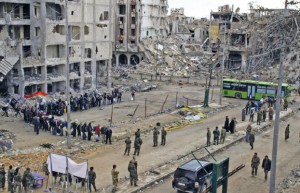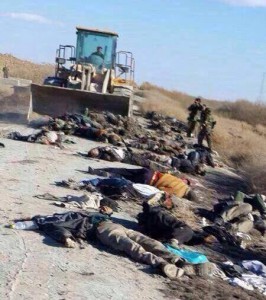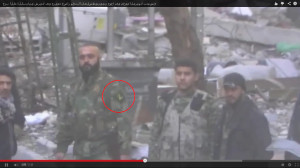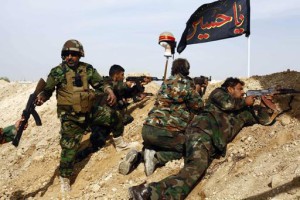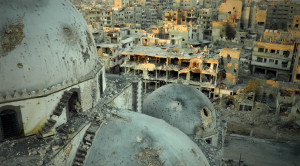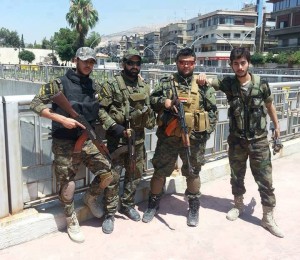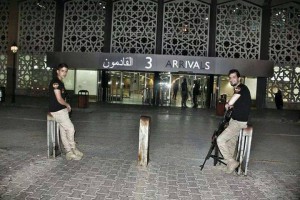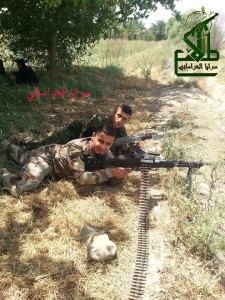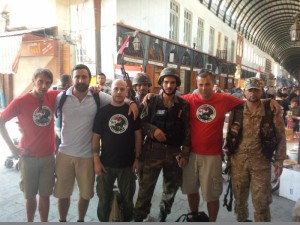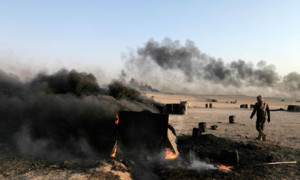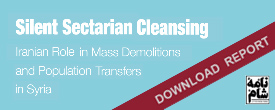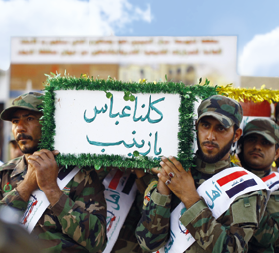 Contents of this section:
Contents of this section:
Early involvement
Send in the Hezbollah boys
The battle of al-Qusayr
From a supporting to a leading role
Homs
Yabroud
Testimonies
Case study: Hezbollah and the al-‘Otaibeh massacre
Case study: Hezbollah in al-Yarmouk
Holy wars
Case study: Hezbollah denounces destruction of (Shia) holy sites in Syria
Iraqi militias in Damascus… and beyond
‘You are protecting Syria, not only the shrine’
Case study: Al-Nabek massacres
Afghan fighters
‘More Shia than Sunni mercenaries now fighting in Syria’
European fascists
‘Sleeping with the enemy’
Notes & References
2. Foreign militias
Providing advice, training and money to the Syrian regime’s armed forces and militias was not enough. As the revolution was pushed towards militarisation and opposition armed forces started to achieve military advances on the ground, the Iranian regime made a strategic decision to send some of its loyal militias in Lebanon and Iraq to go and fight in Syria alongside, and even on behalf of, the Syrian regime forces. This was because, in the words of Mohsen Sazegara, a founding member of Sepah Pasdaran, “One of Iran’s wings will be broken if Assad falls. They are now using all their contacts from Iraq to Lebanon to keep him in power.”54
According to some observers, another factor behind this decision may have had to do with Iranian commanders’ views of the shabbiha’s practices – although the authors of this report believe this issue is rather exaggerated and not as crucial as it is presented in the following quote. The Iranian regime may have well been pursuing parallel, apparently conflicting strategies in Syria.
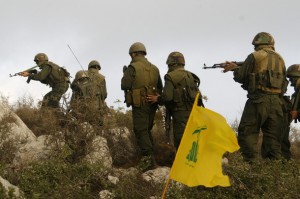
According to Stratfor emails leaked by WikiLeaks in March 2012, members of Sepah Pasdaran and Hezbollah Lebanon were deployed in Syria in the early days of the revolution to “stand behind Syrian troops and kill Syrian soldiers immediately if they refuse to open fire.”
According to the American intelligence think-tank Stratfor, Iranian officials privately describe the shabbiha as “unruly and grossly undisciplined.” One Iranian source reportedly described the shabbiha’s use of violence as “misguided” and explained how Sepah Pasdaran “unsuccessfully attempted to convey to the Syrian militiamen that violence must be employed strategically so as to suppress and not proliferate unrest.” For this reason, the source claims, Sepah Pasdaran “has given up on training the shabbiha and has instead deployed Hezbollah Lebanon members to work with them and, in some cases, even defend shabbiha who have more recently become targets of attacks by the rebel Free Syrian Army.”55
As the previous section has shown, the claim (made in January 2012) that Sepah Pasdaran has “given up” on training the shabbiha and the NDF is unfounded. There is plenty of evidence to the contrary, although Sepah may have well delegated some of this responsibility to Hezbollah, whose members and commanders are trained by Sepah Pasdaran in the first place. Language barriers may have been a factor in this, as Hezbollah commanders, being native Arabic speakers, would find it easier to communicate with Syrian trainees than their Iranian counterparts.
A report by the news agency AFP in April 2014, based on interviews with Hezbollah Lebanon members, revealed details of the training programmes that the group’s fighters undergo before going to fight in Syria: “Initial training for those who pass scrutiny of their religious credentials and background checks, is carried out in Lebanon, where courses last from 40 days to three months. Additional training is provided in Iran for about two months, with a focus on heavy weaponry and preparing members for command positions.” This experience is then also conveyed to Syrian regime forces and militias, whom Hezbollah fighters criticise as being “woefully unprepared.”56
In any case, the “strategic employment of violence to suppress and not proliferate the unrest” does provide a partial explanation for the Iranian regime’s motivation behind sending Hezbollah Lebanon and Iraqi militias to go and fight in Syria. According to Stratfor emails leaked by WikiLeaks in March 2012, members of Sepah Pasdaran and Hezbollah Lebanon were deployed in Syria in the early days of the revolution to “stand behind Syrian troops and kill Syrian soldiers immediately if they refuse to open fire.”57
Early involvement
Rumours and reports of Hezbollah Lebanon and Iraqi militias’ presence inside Syria have been around at least since mid-2011. One of the earliest videos of Hezbollah’s presence in Syria, published in July 2011, shows Hezbollah fighters with machine guns and tanks in Horan in southern Syria.58 In January 2012, The Times reported that the Syrian regime was deploying “large numbers of Hezbollah and Iranian snipers” to shoot anti-regime protesters.59 The report’s source was a Syrian Treasury auditor at the Ministry of Defence who had defected and fled Syria the month before. According to him, the salaries of these snipers, who were imported as ‘military consultants’, were paid through a “slush fund replenished with US dollars flown in from Iran.” It was the same fund used to pay the shabbiha, he claimed.
One of the earliest videos of Hezbollah fighters in Syria – Horan, July 2011.
In February 2012, Syrian regime forces, supported by Hezbollah fighters, regained control of the town of al-Zabadani, north-west of Damascus, after rebels had taken over it the previous month. A few days before, Al-Arabiya TV channel had quoted a Sepah Pasdaran commander saying Hezbollah forces took part in the al-Zabadani battle, on Iranian orders, in order to protect a Sepah Pasdaran military base in the nearby town of Madaya.60 According to media reports, al-Zabadani, which is situated on the way between Damascus and Beirut, has served as Sepah Qods’s “logistical hub” for supplying Hezbollah Lebanon with arms at least since June 2011.61 According to US estimates, Hezbollah was at the time receiving $100 million a year from Tehran in supplies and weaponry, which were transported through Syria.62
In October 2012, a senior Hezbollah Lebanon commander was reported to have been killed in Syria.63 Hezbollah said Ali Hussein Nassif had died while “performing his jihadist duty,” without specifying where.64 Syrian rebels said Nassif and several of his men had been killed in an ambush by the Free Syrian Army. Other reports said they had died in clashes on the border. Nassif was the second senior Hezbollah military commander to have reportedly been killed in Syria. Musa Ali Shahimi died in August 2012 and a public funeral attended by two Hezbollah MPs was held for him in Beirut.65
A few months before, in March 2012, Hezbollah held funerals for two other, less senior members who, according to the Syrian opposition, had been killed in al-Mazzeh, Damascus.66 After Nassif’s death, however, many more public funerals followed. Syrian rebels also published a number of videos of Hezbollah fighters they had captured or killed in Syria.67 It was no longer a secret, especially after the US Treasury added Hezbollah Lebanon to its sanctions list in August 2012 for “supporting the Assad regime,” not only for being a “terrorist group.”68 In a special briefing on the designation, the Treasury’s Under-Secretary for Terrorism and Financial Intelligence claimed that Hezbollah, in addition to training Syrian regime forces and providing them with logistical assistance, had also played “a substantial role in efforts to expel Syrian opposition forces from areas within Syria.”69
The following month, in September 2012, the US Treasury targeted with sanctions Hezbollah Lebanon’s leader Hassan Nasrallah himself for his role in supporting the Assad regime. Nasrallah has personally “overseen Hezbollah’s efforts to help the Syrian regime’s violent crackdown on the Syrian civilian population,” the department said in a press release.70 Yet Nasrallah and other Hezbollah Lebanon spokespeople kept denying at this point that the group had any involvement whatsoever in Syria and accused the Syrian opposition and its backers of fabricating ‘lies’ to undermine the ‘resistance’.
Send in the Hezbollah boys
Like Nasrallah, Iranian officials also kept publicly denying that Iran had any direct military involvement in Syria and insisted they had nothing to do with what ‘other groups’ were doing there. In a famous statement about two years later, Iranian foreign minister Mohammad Javad Zarif told the World Economic Forum in Davos: “We are not sending people. Hezbollah has made its own decision.”71
But others, including Hezbollah and Iranian regime insiders, disagree. Sheikh Subhi al-Tufayli, who led Hezbollah Lebanon between 1989 and 1991 before he fell out with the Iranian regime, told Reuters in an interview in 2013 that Hezbollah’s decision to intervene in Syria had been entirely down to Iran:
I was secretary-general of the party and I know that the decision is Iranian, and the alternative would have been a confrontation with the Iranians… I know that the Lebanese in Hezbollah, and Sayyed Hassan Nasrallah more than anyone, are not convinced about this war.72
The news agency also quotes a Lebanese security official saying: “Even if Hezbollah has its wise men, the decision [to fight in Syria] is not theirs. The decision is for those who created and established [Hezbollah]. They are obliged to follow Iran’s orders.” In another interview in July 2013, al-Tufaili said: “Although Iran does not get involved in all the little details [of Hezbollah Lebanon], political decisions are always 100% Iranian.”73
The ‘tipping point’ behind the Iranian regime’s decision to adjust its Syria strategy (from an indirect, supervisory and supporting role to heavy, direct involvement) appears to have occurred in Summer 2012, after Syrian rebels captured large sections of Aleppo and of the suburbs of Damascus. Fearing that the Assad regime would soon collapse, Tehran dispatched senior Sepah Pasdaran commanders skilled in urban warfare to supervise and direct military operations. According to US and Iranian officials, Sepah Qods established “operation rooms” to control cooperation between Sepah Pasdaran, Syrian regime forces and Hezbollah Lebanon.74 In June 2013, Syrian rebels in Aleppo intercepted and recorded what appears to be a radio transmission between an Iranian commander and another from Hezbollah (judging by their language and accent), in which the first gives the second military instructions.75 Sources in the Free Army in Aleppo reported clashing with Hezbollah fighters for the first time in July 2012.76 The month before, media reports claimed Hezbollah fighters were involved in the Douma and Saqba massacres near Damascus.77
It is worth noting at this point that at least some of these reports originating from the Free Syrian Army or the Syrian opposition about Hezbollah’s activities in Syria in 2011-12 appear to have been exaggerated for political purposes. But this does not mean they were entirely without basis. Many reports that were initially discredited by ‘experts’ turned out to be true later, when more evidence, admissions and confessions regarding Hezbollah’s operations in Syria came to light.
As early as June 2011, the countryside of al-Qusayr, near Homs, along the Syrian-Lebanese border, had witnessed the first clashes between Hezbollah fighters and Syrian rebels. Hezbollah fighters, supported by Syrian regime rocket launchers, allegedly attempted to cross the border and enter the strategic Syrian village of Rableh. They subsequently captured eight border villages inhabited by mixture of Sunni, Shia, Alawi and Christian residents.78 The following year, in May 2012, Hezbollah invaded more villages in the area and established fortified bases for itself there.
In a speech on 11 October 2012, Hezbollah’s leader Hassan Nasrallah justified these actions by claiming the fighters were Lebanese nationals who had lived in these Syrian villages for many years (there are 23 of these villages and 12 farms, whose population is estimated to be around 30,000). Many of them, he claimed, “decided to stay in their homes, bought weapons… to defend themselves and their properties” against armed groups who attacked them.79 “Some of the youth among them happened to be Hezbollah members,” he added. “We did not tell them what to do… and this has nothing to do with the fighting between the Syrian government and the armed groups.”
This was the first in a series of justifications that Nasrallah and other Hezbollah officials would reiterate in front of their supporters, the other main one being “defending holy Shia shrines” in Damascus (more on this below).80 It was also the first official half-admission of Hezbollah’s involvement in Syria and a signal for a later, full-scale military campaign starting from the Syrian villages that the group had occupied.
What Nasrallah ‘forgot’ to mention in his speech was the open secret that the Qusayr-Hermel region has historically been a main route for Iranian arms shipments to Hezbollah Lebanon via Syria, and is also close to some of Hezbollah’s main arms depots in the Beqaa Valley in Lebanon. Moreover, Hezbollah would not have been able or willing to intervene in Syria without Iranian training, weapons, money and orders.
The battle of al-Qusayr
A major turning point in Hezbollah Lebanon’s involvement in the Syria war was the battle of al-Qusayr in April-June 2013.81 The strategic town, located close to the Lebanese border and on the highway connecting Damascus to Homs and the coastal region, had been held by Syrian rebels and besieged by the army since November 2011, with sporadic fighting since February 2012. On 11 April 2013, a full-scaled, well-planned military campaign, led by Hezbollah Lebanon and Sepah Pasdaran, was launched with the aim of capturing all villages around al-Qusayr and ultimately al-Qusayr itself. One journalist reported seeing Iranian military commanders inside the city.82
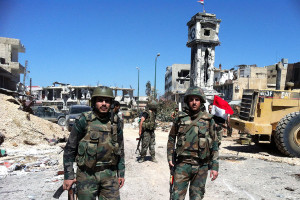
The battle of al-Qusayr in April-June 2013 was a major turning point in Hezbollah Lebanon’s involvement in the Syria war.
On the first day of the operation, a large force of Hezbollah fighters, backed by the Syrian army, attacked and captured the hilltop village of Tell al-Nabi Mando. Over the next few weeks, heavy bombardment and fierce fighting between rebels and Hezbollah and Syrian army fighters continued in various villages around al-Qusayr. For example, on 18 May, the rebels ambushed Hezbollah fighters along the banks of the al-Assi river on the Syrian side of the Lebanese border while they attempted to enter Syria. Ten Hezbollah fighters were reportedly killed. The next morning, a new Hezbollah force was seen heading towards al-Qusayr.
In the early hours of 19 May, planes, artillery and mortars bombarded al-Qusayr. Later in the day, hundreds of Hezbollah fighters, accompanied by Syrian regime troops, stormed the city from several directions. The rebels fought back and initially managed to push them back to their starting positions on the outskirts of the city. Hezbollah reinforcements were reportedly sent across the border to back them up. On 5 June, Syrian state TV reported that the Syrian army had gained full control of the city. The rebels stated they had pulled out of the city and retreated north to the village of Dabaa, which was still partially under the rebels’ control. One Hezbollah fighter was quoted saying they took al-Qusayr in a rapid overnight offensive, allowing some of the rebels to flee.83
More than 500 rebels were killed and some 1,000 wounded during the battle. Well over 100 Hezbollah fighters were also killed, according to opposition sources, of whom some 100 were confirmed by Hezbollah. The number of Syrian army soldiers who were killed is unknown.
One reason for the high number of Hezbollah casualties was that the group played a leading role in the battle of al-Qusayr. According to one Hezbollah fighter interviewed in June 2013,
Hezbollah is leading operations in Qusayr; the Syrian army is only playing a secondary role, deploy[ed] after an area is completely ‘cleaned’ and secured. Hezbollah officers coordinate with the People’s Army [NDF] but fighters never interact. The People’s Army is usually last to [be] deploy[ed] after the Syrian army, as they have a better understanding of the area and its residents.84
It was during this time that Hezbollah Lebanon’s leader made his first official admission of sending fighters to Syria. In a televised speech broadcast by Hezbollah’s TV station Al-Manar on 25 May 2013, Hassan Nasrallah described Syria as the “back of the resistance,” so “the resistance cannot stand arms folded while its back is [being] broken.” Hezbollah had entered a new phase a few weeks ago, he added, a phase he described as “the phase of fortifying the resistance and protecting its backbone.” As to sending fighters to Syria, Nasrallah claimed Hezbollah does not force anybody to go to fight in any battle. “We don’t need to declare jihad,” he added, “but with two words you will find tens of thousands of fighters who are ready to take [to] all fronts.”85
After falling into their hands, al-Qusayr was run by Hezbollah as “independent territory,” according to media reports. The group’s commanders were in charge of “maintaining discipline” among Syrian regime forces. They also established an operations base in the town’s northern section that is off-limits to most Syrians. According to one Hezbollah commander who patrolled the town with his fighters in a pickup truck, only regime loyalists were allowed back into al-Qusayr, and only after they were “vetted” by him personally.86
From a supporting to a leading role
The battle of al-Qusayr was viewed by most observers as a major turning point in the Syria war.87 It reflected a noticeable shift in the Iranian regime’s military strategy in Syria: conceding, or perhaps losing interest in, the possibility of regaining control of the eastern and northern parts of the country that were now under the rebels’ control. Instead, the focus from now on would be on defending and consolidating the Syrian and Iranian regimes’ control in Damascus and its surroundings, Homs and its surroundings (which connect the first with the coastal region), and the Qalamon region (which connects the first two and connects both with Lebanon).88
The aim was to secure the capital, whose fall would have been seen as a fall of the regime, and to secure the Damascus–Homs–Coast corridor in order to both provide a geographical and demographic continuity of regime-held areas and secure arms shipments to Hezbollah in Lebanon, while at the same time cutting off those of the rebels coming from or through eastern Lebanon.89 The leading role in these keys battles would be assigned to Hezbollah and other Iranian-backed militias, who were seen as more reliable and better organised than the regular Syrian army. Meanwhile, the regime’s air force would continue its long-range bombardment of rebel-held areas in the north and the east to perpetuate a state of war in those areas and make life there unbearable. The barrel bombs campaign on Aleppo is an obvious example of this.90
This new strategy and the leading role assigned to Hezbollah are best reflected in a number of key, strategic battles in which the group took part.91 One of these was the two-year-long campaign to retake Homs and its countryside, of which the al-Qusayr battle was but a part, and in which Hezbollah played a key role.
Homs
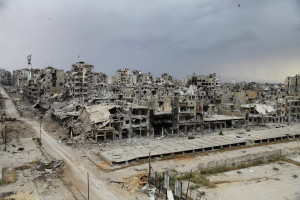
Hezbollah Lebanon played a key role in the two-year-long campaign to retake Homs and its countryside.
In May 2011, as mass protests spread to Homs and the city was dubbed “the capital of the revolution”, regime forces and militias carried out a brutal crackdown against the protesters in an attempt to quell them, and the city was placed under a suffocating siege that would last for three years (until May 2014). An increasing number of army defectors were joined by some of the protesters who picked up light arms to defend themselves. In October and November 2011, the rebels resisted repeated attempts by the regime forces to enter the district of Baba Amr.
In February 2012, Syrian regime forces launched an offensive against Baba Amr, shelling the entire district and blocking all supply routes. In early March, ground troops pushed their way into the neighbourhood, forcing the rebels to withdraw. By early May 2012, following a UN-brokered ceasefire, only sporadic street fighting and shelling was taking place and regime forces and militias were in control of most of the city (75-80 per cent). A brigadier-general who defected was quoted by the media saying that the Syrian regime forces and militias were led by Iranian military ‘advisors’.92
In December 2012, regime forces also captured the district of Deir Baalba, leaving only the Old City, the al-Khalidiyya district and a few other areas of Homs under rebel control. In early March 2013, they launched an assault into several rebel-controlled neighborhoods but the rebels, reinforced by units arriving from al-Qusayr, managed to repel the attacks. On 2 May 2013, however, the Syrian army, along with Hezbollah, Iraqi and Iranian fighters, pushed into Wadi al-Sayegh in the heart of the city and regained control of the strategic neighbourhood, cutting off all links between the Old City and the al-Khalidiya district. On 26 July, regime and Hezbollah forces advanced further into al-Khalidiyya and eventually captured 60 percent of the district, including the historic mosque of Khalid Ibn al-Walid.
It is worth noting that almost none of the early reports documenting the crimes committed in Homs at this stage mentioned Hezbollah’s or the Iranian regime’s role.93 Reports by the Syrian opposition or the Free Army talking about such a role were often dismissed as ‘fabrications’, ‘exaggerations’, ‘propaganda’ or ‘conspiracy theories’. Yet, later reports revealed that at least some Syrian regime forces and militias were fighting under Hezbollah and Iranian commanders. In September 2013, The Wall Street Journal quoted a 19-year-old Syrian militiaman who “fought under a Hezbollah commander in a district called Khalidiya.”94 “If we take back all of Homs,” he added, “the revolution is going to be completely finished.”
In early May 2014, following two months of negotiations, the Iranian regime brokered an unprecedented deal with the Homs rebels that was hailed as a “victory for al-Assad.”95 The terms of the deal included a ceasefire in the Old City of Homs, which had been under siege for over two years, and the safe withdrawal, under UN supervision, of some 2,000 opposition fighters with their light arms from all the besieged areas of Homs to the northern parts of the country. In return, 45 hostages and prisoners of war held by the rebels in Aleppo and Latakia were released. The rebels also agreed to ease their siege on Nubl and Zahraa, two predominantly Shia, pro-regime towns north of Aleppo.96
Earlier reports had claimed that the deal would involve the release of a disputed number of Sepah Pasdaran and Hezbollah Lebanon fighters who had been captured by the Islamic Front, an alliance of several Syrian Islamic rebel groups. Some said this referred to a Sepah Qods commander held by the Baydaa Martyrs Battalion in Homs, but could be expanded to include the release of other Iranian prisoners of war, as well as ten Hezbollah fighters held by the Islamic Front. French news agency AFP then quoted one of the Syrian opposition’s negotiators saying the negotiations had entered “a new phase” that involved the Liwa al-Tawhid brigade, which was negotiating the release of “two Iranian officers” held by the group in Aleppo. Other media reports mentioned a Russian military officer who had been held by the Islamic Front in the suburbs of Latakia. But later media reports gave conflicting accounts of whether all of these foreign hostages were actually released as part of the deal. Moreover, some of the evacuated rebels were later arrested and executed by the regime, according to the opposition.97
Whatever the truth is, it is certain that Iranian officials played a prominent role in brokering the deal on behalf of the Assad regime.98 According to Syrian opposition sources, the negotiations took place at al-Safir hotel in Homs in the presence of representatives from the UN. The opposition side was represented by a few rebel commanders and community leaders from the besieged areas of Homs. The regime side was represented by a high-ranking Syrian officer (the head of the Political Security branch in Homs), the governor of Homs, in addition to the Iranian ambassador to Damascus and a “senior Iranian commander” believed to be from Sepah Qods. The Iranian embassy in Damascus had been handling negotiations to secure the release of Sepah Pasdaran personnel held in Aleppo. According to media reports, a similar deal that was negotiated, without success, in the besieged, rebel-held district of al-Wa’r in Homs the following month included a clause about “opening an office for the Iranian mediator to deal with any breach of the agreement.”99
As the then vice-president of the National Coalition, the main Syrian opposition body, put it, the Homs deal “reflects al-Assad regime’s subordination to Iran and the fact that it has become the main importer of terrorism in the region… It has shown that [the Syrian regime] is little more than a tool in the hands of external forces [Iran and Russia] that are trying to impose their dominance over Syria.”100 One activist from Homs also told WSJ, “Without the Iranian prisoners, we couldn’t have reached this life-saving deal. The regime never cared about its people, even its own soldiers.”101
Yabroud
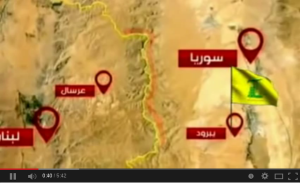
A Hezbollah propaganda song entitled “The Victory of Yabroud” by Ali Barakat, broadcast by Al-Manar TV on 16 February 2014.
Another strategic battle in which the Iranian regime and Hezbollah were heavily involved was that of Yabroud in February-March 2014.102 Following a month of fierce resistance by opposition fighters, this strategic town in the Qalamon region fell into the hands of Hezbollah and Syrian regime forces. The main reason for this was that Hezbollah Lebanon had thrown in its full force behind the campaign. Media reports claimed the group had sent at least 2,000 of some its best fighters to fight in Yabroud,103 in addition to fighters from the notorious Iraqi Shia militia known as the Badr Legion, which was set up by Sepah Pasdaran during the Iranian-Iraqi war.104
All sorts of weapons were used to pave the way for the ground troops, from Russian and Iranian missiles (Scud and Burkan) to cannons and barrel bombs.105 As one local activist from the Yabroud Coordination Committee put it, “the amount of missiles fired on Yabroud, and the number of troops amassed, would have been enough to destroy large parts of Israel or take over Washington DC.” Significantly, it was not just the Syrian air force firing rockets and barrels; Hezbollah Lebanon was also firing its own missiles.106
The fall of Yabroud was portrayed by Hezbollah, Syrian and Iranian state-controlled media as a ‘victory’, even though the huge, month-long military campaign had cost Hezbollah and Iran a great deal of money, weapons and souls – not to mention the obvious question of whether flattening a whole historical town and displacing its entire population can ever be regarded as a victory. Like the battle of al-Qusayr, Hezbollah and Sepah Pasdaran seemed to have underestimated how long and how much it would take to ‘conquer’ Yabroud.
Meanwhile, a growing number of people living in Hezbollah strongholds in Lebanon were growing increasingly “tired of the war” as the human and economic costs of Hezbollah’s adventures in Syria continued to climb, not to mention growing fears that their areas were becoming part of the Syria war (as targets for suicide bombs). In fact, such fears were used by Hassan Nasrallah and other Hezbollah leaders in their public speeches to justify the Yabroud campaign and the group’s involvement in Syria more generally. In a speech in February 2014, Hezbollah’s Deputy Secretary-General Naim Qassem claimed that Yabroud was “the main source” of the explosive-rigged cars that had targeted civilian areas in Lebanon, mainly Hezbollah strongholds, in recent weeks.107
Testimonies
Various testimonies by Hezbollah fighters confirm the leading role of Hezbollah Lebanon in Syria, where it reportedly had thousands of fighters on the ground by mid-2014. For example, an AFP report in April 2014 quoted a Hezbollah fighter saying the Syrian army soldiers “have no experience in urban warfare or how to deal with a guerrilla force, so we lead the way in battle and have trained them on how to conduct themselves and use certain weapons.”108
In another article, published in The Lebanon Debate in February 2014, Hezbollah fighters who participated in battles inside Syria were quoted saying:
There are some soldiers in the Syrian army who are sympathetic to the opposition, and others who would sell information to anyone who pays for it.
We got to a point where we, in Hezbollah, could no longer go to sleep altogether. One or two people would stay up to ensure that we won’t be betrayed one night.
During the Qusayr battle, it became necessary that one Hezbollah member would accompany every Syrian army tank. And this procedure is still followed to date in all the battles in which Hezbollah fighters participate.
This issue [untrustworthy Syrian army officers] is being dealt with by bringing in non-Syrian pilots in order to ensure the precision of air strikes against target sites.
The fighters of the National Defense [Forces] do not betray. They fight to the last moment and follow orders. These we trust a lot, and the [Hezbollah] leadership now prefers to fight battles jointly with them rather than with any other Syrian armed formation.109
The Lebanon Debate interviewees’ account of the Qusayr and Eastern Ghouta battles corroborate previous accounts by other Hezbollah fighters published in the past.110 It is therefore reasonable to believe that what they say in this interview is accurate and reliable.
In addition to its leading role in battles, Hezbollah also expanded its presence in Syria geographically. According to one Hezbollah fighter, “At the beginning of the war, elite forces were initially responsible for protecting Shiite shrines. They have now been deployed in different Syrian areas. Besides Qusayr, we are now fighting in Aleppo and rural areas surrounding it, as well as the suburbs of Damascus, Hama, and Idlib. In the Damascus suburbs and Aleppo, we are leading similar operations than those launched in Qusayr due to the nature of the terrain.”111
Case study: Hezbollah and the al-‘Otaibeh massacre
On 26 February 2014, more than 175 Syrians were executed by Hezbollah Lebanon and Syrian regime forces near the town of al-’Otaibeh in the eastern suburbs of Damascus.112 The high-profile operation was described by Syrian, Lebanese and Iranian state-controlled media as a “tight, pre-planned ambush” of “heavily armed al-Qaeda terrorists.” But evidence suggests the victims were either unarmed civilians or prisoners of war who were executed en masse in breach of international laws and conventions. Moreover, pictures of how their corpses were treated afterwards – using bulldozers to dump them in the wild – caused shock and outrage across the world.
A short video posted on YouTube,113 which activists claimed was obtained from a member of Hezbollah Lebanon, shows two officers in military uniform on the scene joking about the corpses of the ‘Otaibeh massacre with a distinctive Lebanese accent. One of them also appears to be wearing a badge that looks similar to the distinctive yellow badge worn by Hezbollah Lebanon fighters. The quality of the video is bad (it seems to have been taken with a mobile phone) but both things can nonetheless be noticed.
Moreover, Hezbollah Lebanon’s official TV channel Al-Manar broadcast on the same day “exclusive footage” of the first moments of the ‘ambush’.114 A night-vision camera shows a row of people marching before two mines explode and heavy gun shots are heard.
Both pieces of evidence suggest that Hezbollah Lebanon was not only involved in carrying out the ‘Otaibeh massacre but was also involved in planning and preparing for it. This begs the question: were Iranian Sepah Qods commanders, who are known to coordinate and direct Hezbollah’s key operations in Syria, also involved in the orchestration and implementation of this and other massacres?
Case study: Hezbollah in al-Yarmouk
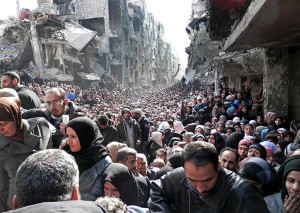
Residents of the Yarmouk Palestinian camp in Damascus rushing to receive food baskets distributed by the UN, 31 January 2014.
Like many other densely populated areas across the country, and under the pretext of harbouring opposition armed groups, the al-Yarmouk Palestinian refugee ‘camp’ in Damascus was placed under a suffocating siege for over a year by Syrian regime forces, aided by members of the Popular Front for the Liberation of Palestine – General Command and members of Fatah al-Intifada. As a result, over 150 Syrian-Palestinians had died from starvation and malnutrition by the end of May 2014, according to the Action Group for the Palestinians of Syria.115 Almost 1,000 more had been killed by regime shells, snipers or under torture.
In April 2014, the spokesperson of the United Nations Relief and Works Agency for Palestine Refugees (UNRWA) described the situation in Yarmouk as follows: “It is unprecedented in living memory for a UN-assisted population to be subject to abject desperation in this way… the sheer humanitarian facts cry out for a response.”116
Even though it is not recognised by UNRWA as an official refugee camp, al-Yarmouk is the largest Palestinian residential area in Syria. Before its near-complete destruction by the Syrian regime, it stretched over 2 square kilometres and housed over 170,000 registered refugees, according to official 2013 statistics. Unofficial statistics put the number higher. Tens of thousands of internally displaced Syrians had also come to the camp from neighbouring areas targeted by regime forces.
One controversial aspect of the siege of al-Yarmouk has been the alleged involvement of the Iranian regime and Hezbollah Lebanon, given their rhetoric in support of Palestinian rights. In June 2014, activists published a video from al-Yarmouk showing members of Hezbollah Lebanon participating in the beating and humiliation of Syrian-Palestinians queuing for food parcels, along with members of the General Command and Syrian shabbiha, and in the presence of UNRWA staff.117 Previous, unconfirmed reports had claimed Hezbollah fighters were taking part in fighting against opposition armed groups inside the camp.
These and other reports have led many Palestinians and Syrians to accuse Hezbollah Lebanon and the Iranian regime of ‘hypocrisy’, particularly after their fiery statements about Palestinian rights in the wake of the Israeli attack on Gaza in July 2014.
Holy wars
In August 2012, the Kuwaiti newspaper Al-Seyassah published a report claiming that Iran’s Supreme Leader Ayatollah Ali Khamenei had instructed two prominent Shia religious authorities (marji’yyat) in Iraq and Iran to issue a fatwa (religious ruling) calling for Shia jihad against ‘takfiri groups’ in Syria.118 Al-Seyassah is known for its politically motivated reports and fabrications, but at least the Iranian fatwa appears to be authentic.
Qom-based Kazem al-Haeri had published on his official Facebook page a fatwa authorising and legitimising travelling to Syria to take part in ‘holy jihad’ in defence of Shia shrines.119 The fatwa came in the form of a response to a request for permission to travel to Syria for the purpose of defending the shrine of Sayyida Zaynab in Damascus without parental permission. Al-Haeri ruled that this action was permissible and that parental permission in such matters was unnecessary. “The battle in Syria,” he later added, “is not only for the defense of the shrine of Sayyida Zaynab but it is a battle of infidels against Islam, and Islam should be defended.”120
Originally from Iraq, al-Haeri had previously published a book with various fatwas concerning matters of warfare, especially unconventional guerilla warfare.121 Some of his fatwas, such as killing prisoners of war and innocent individuals “if necessary”, go against international human rights conventions. Before al-Haeri, another Iranian Shia authority, Ayatollah Seyed Mohammad Sadeq Rouhani, had also legitimised jihad in Syria for the purpose of protecting Shia holy sites.122 Another Iraqi fatwa by the Najaf-based Shia cleric Abu al-Qasim al-Ta’i, who has strong connections with one of the Iraqi militias fighting in Syria, also permitted Iraqi Shia to travel to Syria for ‘jihad’.
These Shia fatwas followed other alleged fatwas by little-known or anonymous Saudi clerics calling for the destruction of Shia shrines,123 as well as an alleged YouTube video in which a group said to belong to the Free Syrian Army called for the destruction of Sayyida Zaynab and other Shia shrines.124 The authors of this report have not been able to find this alleged video online, and the origin of the story appears to be a news item broadcast by the notorious Saudi TV channel Wisal merely “calling upon” the Free Syrian Army to “target the temple of Sayyida Zaynab and destroy it.”125 Early statements by Shia leaders seem to support this conclusion.126
The previous month, in June 2012, a suicide bomber had detonated a van packed with explosives in the Sayyida Zaynab district, wounding 14 people and causing some damage to the shrine.127 Syrian state TV was quick to blame the rebels (or ‘the terrorists’, as it usually called them) for the attack, as did the representative of Iran’s supreme leader in Syria Mojtaba al-Hosseini.128 It was not clear, however, who was actually behind the bomb and whether it was intended to target the shrine itself or a police station 15 metres away.
The Free Army had taken over the neighbourhood earlier that year until its fighters were driven out, in late July 2012, by regime forces and militias, supported by Iraqi militias, following fierce fighting and many casualties on both sides.129 The Free Army could have destroyed the shrine then if that had been their intention. The battle was more likely over the strategic location of the district as a gateway into southern Damascus and the Damascus airport further east.
In any case, for many Iraqi Shias, the news and rumours of the Sayyida Zaynab shrine being targeted or threatened by Sunni extremists was a reminder of the 2006 bombing of the al-Askari shrine in the Iraqi city of Samarraa, which was then blamed on al-Qaeda and set off years of retaliatory bloodshed between Sunni and Shia extremists. So it is understandable that the news would create a great deal of concern among the Shia communities. It was indeed used extensively by supporters of Hezbollah Lebanon and various Iraqi militias to call for Shia jihad in Syria. Historical Shia grievances and notions of victimhood were also invoked to advance this call, with slogans such as “revenge for Hossein” and “O Zaynab, you will not be captivated twice”130 becoming widespread.
It is also worth noting that both Mohammad Sadeq Rouhani and Kazem al-Haeri, who belong to a school of thought supporting political Shia Islam, are normally considered second-degree authorities and are less credible and popular than other religious leaders in Qom, Iran. But both are known to be close to Hezbollah and the Iranian regime. Al-Haeri is also said to be the ‘spiritual leader’ of ‘Asa’eb Ahl al-Haq, one of the main Iraqi militias fighting in Syria.131 Their fatwas – even though they were opposed by other prominent Shia authorities 132 – were used to open official registration offices in Iran for enrolling volunteers wishing to go for jihad in Syria.133
In Iraq, a statement by Shia seminaries called upon the Iraqi government to take measures to protect holy Shia shrines in Syria, particularly that of Sayyida Zaynab.134 A conference “in support of Zaynab” was organised in Karbalaa in July 2012, bringing together representatives from various Shia seminaries and groups. One of the outcomes was the establishment of “committees to support the Syrian people… against the enemies’ conspiracies.” A “popular delegation” was also sent to Damascus to “visit” the Sayyida Zaynab shrine.135
Soon various Iraqi Shia militias – all funded, armed and directed by the Iranian regime – were recruiting more fighters to go and fight in Syria under the pretext or belief of protecting holy Shia shrines against Sunni extremists.136 Moreover, their travel across the border was overlooked, and even facilitated, by the Iraqi government of Nouri al-Maliki.137 Like Bashar al-Assad in Syria, al-Maliki was a close ally of the Iranian regime.
Meanwhile, the Syrian regime had set up so-called ‘popular committees’ to defend the Sayyida Zaynab shrine. They were presented by Syrian and Iranian state-controlled media as “local youths, armed with sticks and knives, [who] have formed committees to protect the holy shrine of Sayyida Zainab.”138 But video footage of the ‘popular committees’ in action only shows heavily armed regime troops and shabbiha, just like in other parts of the country.139 And as discussed above, the Iranian regime had played an important role in setting up, training and arming these shabbiha.
Case study: Hezbollah denounces destruction of (Shia) holy sites in Syria
In late March 2014, Hezbollah Lebanon issued a statement condemning “terrorist organisations” for destroying “holy shrines and Islamic and Christian sanctities in Syria.”140 The statement was in reaction to a decision by the Islamic State in Iraq and Sham (ISIS) to demolish what’s left of Uwais al-Qarani’s shrine in al-Raqqa, Syria.
Uwais al-Qarani was one of the prophet’s contemporaries who was killed in battle whilst fighting in Imam Ali’s army. He is highly regarded by Shia Muslims. His shrine in al-Raqqa was renovated and expanded by the Iranian government in recent years, modelled on prestigious Shia shrines in Iran, Iraq and elsewhere.
That same month, the Syrian Network for Human Rights released a report documenting the partial or complete destruction of 1,451 mosques across Syria.141 All were destroyed by Syrian regime shells and bombs, either as a result of indiscriminate bombardment of civilian areas, such as in Aleppo, or by targeting the mosques directly because they were being used as ‘protest hubs’ or as alleged bases for opposition armed groups.
Interestingly, one of the destroyed mosques in Aleppo documented in the report is named after Uwais al-Qarani as well. It was being used as a school after all schools in the area had been destroyed, until it was destroyed by three barrel bombs dropped by regime helicopters, followed by a missile that hit the mosque directly. Three children died as a result, in addition to over 20 others wounded.
As Naame Shaam’s editors put it in a commentary on the story at the time, “There are two ways of reading Hezbollah’s statement: either it is opportunistic hypocrisy (focusing on some shrines while ignoring others), or it is sectarian (only concerned with Shia holy sites and not others). In this sense, Hezbollah is not very different from ISIS. The addition of ‘Christian’, almost as an afterthought, is a too-obvious attempt to cover this sectarianism. All attacks on religious sites should be condemned, but not in a selective, sectarian way.”142
Iraqi militias in Damascus… and beyond
Unlike Hezbollah Lebanon, Iraqi Shia militias did very little to hide their involvement in Syria. One of the first Iraqi militias to announce its presence there, with the stated aim of defending the Sayyida Zaynab shrine, was the Abu al-Fadl al-Abbas Brigade, which observers describe as “the primary front group [of] Iranian-backed combatants and organizations based in Iraq.”143 In a video posted on YouTube in January 2013, a masked man speaking with an Iraqi accent read out what he called “Declaration No. 1” of Abu al-Fadl al-Abbas Brigade, whose task, he stressed, was “to protect the shrine of our beloved lady Sayyida Zaynab against the attacks of takfiris, Wahhabis, the so-called Free Army and all the enemies of the Prophet’s family.”144
A few months before, in October 2012, one of the brigade’s founders, an Iraqi defector from Muqtada al-Sadr’s Jaysh al-Mahdi (the Mahdi Army) was quoted by Reuters saying: “We formed the Abu al-Fadl al-Abbas brigade, which includes 500 Iraqi, Syrian and some other nationalities… When the fighting erupted in our areas [Sayyida Zaynab], we carried out some joint military operations side by side with the Syrian army to clean up areas seized by rebels.”145
Most of the brigade’s members at the time were former fighters in the Mahdi Army of various nationalities, mostly Iraqi, who took refuge in Syria after 2007, when the militia group was crushed by Iraqi and American forces. Others crossed over later to join the ‘holy jihad’.146 Some media reports claimed the brigade was formed in coordination with the Syrian government and Khamenei’s office in Damascus.147
Throughout 2013, Abu al-Fadl al-Abbas Brigade posted tens of promotional videos on YouTube and other social media calling for jihad in Syria to protect the Sayyida Zaynab shrine.148 Hezbollah Lebanon’s Al-Manar TV station was the first proper media outlet to broadcast some of these videos. One of the early, well-produced ones shows Abu al-Fadl al-Abbas fighters alongside what appears to be Hezbollah fighters in the Sayyida Zaynab area.149 About a year later, interviews with serving and former members of Abu al-Fadl al-Abbas Brigade suggested that up to 10,000 volunteers had joined its ranks.150
Another prominent Iraqi Shia militia fighting alongside the regime in Syria is ‘Asa’eb Ahl al-Haq, or Leagues of the Righteous, which shares a similar origin and composition to those of the Abu al-Fadl al-Abbas Brigade, though it is a few years older.151 It was reportedly formed in 2006, as a splinter from the Mahdi Army, with the help of Sepah Qods and Hezballah Lebanon, to fight the American troops in Iraq.152
In July 2013, ‘Asa’eb Ahl al-Haq announced the creation of a new sub-unit called Liwa’ Kafeel Zaynab, or the Protector of Zaynab Brigade.153 Like Abu al-Fadl al-Abbas, Kafeel Zaynab posted a number of promotional videos on YouTube, which were often a mixture of footage of its fighters in action against a backdrop of Shia religious songs or slogans.154 Some of the videos show heavily armed fighters accompanied by tanks, Syrian army soldiers or Hezbollah Lebanon fighters, often outside the Sayyida Zaynab area and Damascus altogether.155
Judging by its relatively high number of casualties and funerals compared to other Iraqi militias, ‘Asa’eb Ahl al-Haq appears to have a large number of fighters in Syria and to be taking part in battles outside Damascus.156 However, besides the fighting, the group also appears to have been charged, along with Kata’eb Hezbollah, another Iranian-backed Iraqi militia fighting in Syria,157 with organising the enlistment and transfer of Iraqi fighters to Syria. One of the group’s commanders was quoted in May 2013 boasting: “I personally get dozens of calls each day from people in the provinces and Baghdad who want to go… We send well-trained ideological fighters.”158 Back in 2011, an Iraqi source close to the group claimed that ‘Asa’eb Ahl al-Haq received around $5 million a month in cash and weapons from the Iranian regime.159
Another group that is reportedly playing this role (coordinating the recruitment and transport of Iraqi fighters on behalf of the Iranian regime) is the Badr Organisation, which split from the Islamic Supreme Council in Iraq. One of the oldest Shia militias in Iraq, Badr was set up by the Iranian regime to fight against Saddam Hussein inside Iraq during the Iran-Iraq war in 1980s. According to one media report, citing an Iraqi politician allied with the group, Iranian commanders had nominated a senior leader within Badr to control Iraqi militias fighting in Syria and coordinate between them and the Syrian regime.160
In July 2013, the Badr Organisation admitted sending 1,500 fighters to Syria.161 The name given to its Syria military wing is the al-Shahid al-Sadr Force, named after the late Grand Ayatollah Mohammed Baqir al-Sadr, the former leader of the Da’wa Movement in Iraq. That same month, the force announced its first Syria death and held a funeral for him in Iraq.162
Other Iraqi Shia militias fighting in Syria include Kata’eb Sayyid al-Shuhadaa, the Imam Hossein Brigade, the Zulfiqar Brigade, the Ammar Bin Yasir Brigade and Harakat Hezbollah al-Nujabaa.163 According to media reports based on interviews with members of some of these militias, around 50 fighters were being flown or bused from Baghdad and Najaf to Damascus every week in 2013, often in small groups of 10-15, and often disguised as ‘pilgrims’.164 Numerous public funerals have also been held in Iraq for these militias’ fighters killed in Syria.165
‘You are protecting Syria, not only the shrine’
Many of these Iraqi militias were established by the Iranian regime in late 2012 and early 2013 with the sole purpose of sending them to fight in Syria under the pretext of protecting Sayyida Zaynab and other Shia shrines. Some already existed and were used by the Iranian regime in its proxy war with the US in Iraq between 2003 and 2011. Each of these militias has at least a few hundred fighters in Syria, all of whom are armed and trained by Sepah Pasdaran. Evidence of this Iranian role ranges from declarations that Ayatollah Ali Khamenei is their supreme religious authority, with his pictures and quotes filling their websites and social media pages, to testimonies by serving or former members about being trained in Iran or serving under Iranian commanders. A BBC interview with ‘Asa’eb Ahl al-Haq’s leader Qais al-Khaz’ali in July 2014 concluded that ‘Asa’eb Ahl al-Haq and its leaders “make no secrets of their links with the Iranians. Their fighters are trained and supplied by Iran.”166
For example, a former Mahdi Army fighter told Associated Press in October 2012 that Iraqi fighters, who “consider the defense of the holy sites to be a religious duty,” were being “supported by Iran,” which he said had been “providing logistical support and small arms to volunteer fighters guarding the shrine.”167 Another fighter explained to The Guardian in June 2013 how the process of going to fight in Syria worked:
The first step is to register with one of the Shia Islamic resistance offices, like [Asa’eb Ahl al-Haq], [the] Mukhtar Army or Iraqi Hezbollah. Then comes a trip to a boot camp in Iran. You have to enrol on a 45-day training course in Iran to [become] specialised in using a specific weapon like rocket launchers, Kalashnikov, sniper rifle or RPGs [rocket-propelled grenades]. After the course, you will be handed over to an Iranian middleman who will take you to Syria to join the brigade.168
Another fighter, who was first trained to use the Kalashnikov on the plains of southern Iraq, said he was then sent to Mashhad in Iran, then to Beirut, and on to Damascus by plane.
Once you get to the capital, there is a training centre near the [Sayyida Zaynab] shrine where all volunteers have to do a quick session of military training. Then they meet with Abu Ajeeb [the Syrian commander of Abu al-Fadl al-Abbas] who asks all the volunteers to be careful and to go home safe.169
Another Iraqi fighter told The New York Times in October 2012 that he had arrived in Damascus two months before on a flight from Tehran. “Dozens of Iraqis are joining us,” he added, “and our brigade is growing day by day.”170 Other interviewees in Iraq, including Shia leaders, told the paper the Iraqi volunteers had been receiving weapons and supplies from the Syrian and Iranian governments, and that Iran had “organized travel for Iraqis willing to fight in Syria on the [Syrian] government’s side.” The Iranian regime, they added, had also pressed Iraqi Shia forces to “organize committees to recruit young fighters.” A senior official from the Sadrist movement and a former member of the Iraqi parliament also told the paper that convoys of buses from Najaf, ostensibly for pilgrims, were “carrying weapons and fighters to Damascus.”171
Indeed, in many of the videos referenced above, Iraqi militants, particularly from Abu al-Fadl al-Abbas and Kata’eb Hezbollah, appear to be well trained and highly organised, with advanced, high-quality arms and uniforms that even the Syrian army does not possess. So much so that one Abu al-Fadl al-Abbas fighter was quoted in The Guardian article mentioned above saying:
There is no need for the Syrian army in Sayyida Zaynab. The brigade’s fighters are protecting everything from the airport to the capital to Sweida, including residential areas, hospitals, government buildings, police stations, schools, mosques and hospitals.172
Most of the Iraqi militias appear to be using RPG-7s, PKM machine guns, SVD-style sniper rifles and Kalashnikov- and M16-style assault rifles. All are supplied by the Iranian regime, as will be detailed later in the report.
In a video posted by Syrian rebels in December 2013, three Iraqi militants captured by the rebels in al-Ghouta, near Damascus, confess to the camera that they had been sent to Syria “for jihad.”173 The second prisoner, who says he was a bus driver transporting fighters from Iraq to Syria, claims that his group, Abu al-Fadl al-Abbas Brigade, comprises of “ideological fighters” who are fighting “for the doctrine… to protect the Sayyida Zaynab shrine,” unlike ‘Asa’eb Ahl al-Haq, to which the first prisoner said he belonged, which he describes as “mercenaries who are paid money” (500 dollars a month). The Syrian rebel then asks him why they were fighting in al-Ghouta and al-Qalamon when there is no Sayyida Zaynab shrines there, to which he responds: “for the doctrine.”
Confessions of Iraqi militiamen captured by Syrian rebels in the suburbs of Damascus, December 2013.
Most of the other details mentioned in the confessions – which are backed up by pictures, videos and documents found on the prisoners’ phones and a USB stick found with them, all of which are shown in the video – have already been mentioned above. However, in a follow-up interview, the first prisoner elaborates on the money issue.
The monthly salary of 500 dollars that ‘Asa’eb Ahl al-Haq fighters receive, he says, is sent to them from Iraq by the militia’s leader Sheikh Qais al-Khaz’ali, who is said to be based in Iran and was released by the American troops in Iraq in a prisoner exchange deal in 2010. Another religious authority associated with the militia, Qasim al-Ta’i, and his secretary also support them by sending other essential goods, such as sugar and rice. The prisoner also confirms that ‘Asa’eb Ahl al-Haq had been “charged” with fighting outside the Sayyida Zaynab area alongside regular Syrian troops and were responsible for some of the worst massacres committed by Iraqi fighters.174
Other evidence of Iraqi militias fighting outside the Sayyida Zaynab area – suggesting they are not really there to protect Shia shrines – includes videos posted on YouTube, either by Syrian rebels or by the Iraqi militias themselves, of them fighting in other parts of the country, such as al-Gouta and Aleppo.175 In fact, the first Syria ‘martyr’ of ‘Asa’eb Ahl al-Haq was reportedly killed in Hama in early 2012.176 A large funeral, attended by many of the militia’s leaders, was held for him in Baghdad.
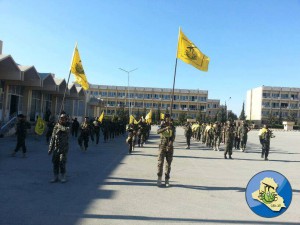
Harakat al-Nujabaa holding a military-style funeral in the Military Engineering Academy in Aleppo, March 2014.
In March 2014, Harakat al-Nujabaa posted pictures on its Facebook page showing its fighters holding a military-style funeral for one of its ‘martyrs’ inside a prominent military facility in Aleppo.177 The place, the Military Engineering Academy, was described by the group as its “headquarters.” Al-Nujabaa split from ‘Asa’eb Ahl al-Haq and reportedly has strong links with Hezbollah Lebanon. In another video posted on YouTube in November 2013, a group of Abu al-Fadl al-Abbas are seen marching down the streets of Aleppo, with one of them shouting “Here we are, Zaynab.”178
There have also been numerous pictures and reports of ‘Iraqi checkpoints’ throughout Damascus. Apart from those in Sayyida Zaynab and the surrounding areas in southern Damascus, Iraqi checkpoints, both stationary and mobile, have been seen in central Damascus (Bahsa and Hamidiyya) and at the Damascus airport, according to local activists. There have also been reports of regime checkpoints manned by Iraqi militiamen.179
These and other similar events and reports have caused at least some of the Iraqi fighters to question what they were really doing in Syria. As one fighter from the Abu al-Fadl al-Abbas Brigade put it in The Guardian article mentioned above,
The moment you join the brigade, you have to join the Syrian government army. You have to fight with President Bashar al-Assad before you fight for [the brigade]. The Syrian army will tell you that you have to know that you are protecting Syria, not only the shrine.180
Interestingly, many Iraqi militia members are now refusing to fight under Syrian command, like Hezbollah fighters did before them. The rift is said to have started around mid-2013, following criticisms by Iraqi commanders of the ‘undisciplined’ behaviour of some Syrian shabbiha they were working with. The disagreements reportedly turned into a gun battle near the shrine of Sayyida Zaynab between ‘Asa’eb Ahl al-Haq, Kata’eb Hezbollah and some Iraqi Mahdi Army fighters on one side and the Syrian commander of the Abu al-Fadhl al-Abbas Brigade and his local followers on the other. Two Iraqi fighters and three Syrian shabbiha died in the clashes. A reconciliation meeting was reportedly held on the order of Khamenei’s office in Damascus, but divisions festered and the Mahdi Army, ‘Asa’eb Ahl al-Haq and Kata’eb Hezbollah are now reportedly fighting under the command of Hezbollah Lebanon.181
In June 2014, following the fall of Mosul to the Islamic State in Iraq and Sham (ISIS), many Iraqi militiamen returned to Iraq to fight against Sunni extremists there.182 According to media reports, Hezbollah Lebanon subsequently announced a ‘general mobilisation’ and sent more than 1,000 additional fighters to Syria in order to fill the gap.183
Case study: Al-Nabek massacres
As part of the Qalamon military campaign in early December 2013, Syrian regime troops, accompanied by Syrian shabbiha and Iraqi militia fighters, particularly from the Zulfiqar Brigade, invaded various villages and towns around the city of al-Nabek.184 Militiamen from the Zulfiqar Brigade committed nine consecutive massacres against the local civilians, according to the Syrian Network for Human Rights.185 At least 150 civilians, including entire families, the majority of them women and children, were executed. The Center for Documentation of Violations in Syria has documented the names of 128 of them.186 Many were slaughtered with knives in the basements of their houses, where they were sheltering from shelling, and their bodies were then burnt.187
Other less-known but well-documented massacres committed by Iraqi militias fighting in Syria include the al-Thiybiyya massacre, near Damascus, in October 2013. According to eyewitnesses, Abu al-Fadl al-Abbas militiamen, accompanied by some Hezbollah and Iranian fighters, entered the town from several directions, then executed and slaughtered an unknown number of unarmed civilians. The Syrian Network for Human Rights was able to document the death and disappearance of 13 entire families, describing the massacre as “bearing the marks of sectarian ethnic cleansing.”188
These and other massacres committed by Iraqi militias in Syria clearly amount to war crimes and crimes against humanity. Yet many of these militias are still not included on international lists of terrorist groups.
Afghan fighters
Unconfirmed reports that some Shia Afghan fighters have been fighting in Syria alongside Hezbollah and the Iraqi militias have been around at least since October 2012, when the Free Syrian Army captured an Afghan refugee from Iran who was allegedly fighting in Syria alongside the regime.189
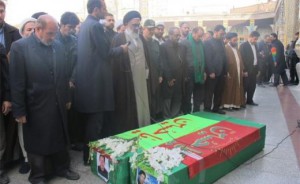
Funeral of an Afghan fighter killed in Syria held in Qom, Iran, and attended by Sepah Pasdaran commanders.
In April 2013, Afghan media reported that the Afghan Foreign Ministry had launched an investigation into the involvement of Afghan nationals in the Syria war.190 A Foreign Ministry spokesperson said at a press co
nference that several Afghan nationals had reportedly been sent by Iran to Syria and a number of them had reportedly been killed there. According to the Syrian opposition, most of them were fighting within ‘mixed’ Iraqi militias, such as Abu al-Fadl al-Abbas Brigade and Saraya Tali’at al-Khurasani.191
Sending Afghan fighters to Syria may have been an attempt by Sepah Pasdaran to bolster the Iraqi militias fighting in Syria at the time, or simply because they are ‘cheaper’ for the Iranian regime than other fighters, as most of the recruits appear to be poor or undocumented Afghan refugees in Iran, so Sepah would not have the same financial commitments towards them and their families as it does to Iranian, Hezbollah or Iraq fighters. It is plausible, however, that using Afghan Shia fighters is also part of longer-term plans by the Iranian regime to consolidate its power in Syria by relying more and more on its own loyal militias instead of Syrian troops (more on this later in the report).
In May 2014, The Wall Street Journal published an explosive article claiming Sepah Pasdaran had been recruiting thousands of Afghan refugees to fight in Syria, offering them $500 a month and Iranian residency permits.192 The allegations were based on an Iranian blog on recruitment efforts among Afghan refugees in Iran and were confirmed to the paper by an Afghan religious leader in Qom and by a member of Sepah Pasdaran. The article caused a storm in Afghanistan and Iran, with Iranian officials insisting the allegations were “baseless” and “unfounded.” But the paper maintained that its claims had been confirmed by reliable sources before the Iranian authorities put pressure on them to “recant their statements.”193
A couple of weeks later, in June 2014, France 24 published another investigation in which it quoted two “observers” based in Afghanistan who corroborated WSJ’s allegations, adding that the deployment of young Afghan Shia fighters was “no secret.”194 One of them said two of his family members, who had fled to Iran a few years before, were sent to Syria after being offered 1.5 million Iranian Tomans (equivalent to 430 euros or 585 US dollars) by Sepah Pasdaran. “They both received military training in Iran for a few months before they were sent to Syria,” he added. “One told me he and 80 other Afghan fighters had received training and fought alongside Hezbollah for a while in Syria.” The other source told the channel that some Afghan Shia clerics were encouraging Shia youths during private gatherings to go and fight in Syria to “defend Shia Muslims in Syria and fight what they call the enemies of Ali.” “I know other youths [who] were recruited from cities such as the capital, Kabul, Balkh, Sarpol, Samangan as well as Faryab and Nimrooz in Afghanistan,” he added.
Around mid-2014, a number of media reports claimed that the Afghan Shia fighters sent to Syria had now formed their own separate militia called the Fatimyyoun Brigade (named after Fatima, Prophet Mohammad’s daughter and Imam Ali’s wife).195 The brigade is estimated to have between 2,000 and 5,000 fighters and appears to be coordinating mainly with Abu al-Fadl al-Abbas Brigade.
In addition to Afghans, there have also been reports of Shia fighters from various other nationalities being sent to Syria or prepared to go. For example, in July 2013, Iranian media reported the death of a Shia fighter from the Ivory Coast in Syria.196 In June 2014, India’s largest Shia organisation allegedly began to recruit volunteers to defend Shia holy shrines in Iraq, and possibly in Syria, against the extremists of the so-called Islamic State (ISIS). Media reports claimed that nearly 30,000 Indian Shia Muslims had already signed up to fight and applied for visas to Iraq.197
‘More Shia than Sunni mercenaries now fighting in Syria’
There are no reliable statistics on the number of foreign Shia fighters in Syria but most estimates place their number in the tens of thousands.198 In January 2014, security experts meeting at the Marrakech Security Forum agreed that there were now far more foreign Shia fighters in Syria than Sunni ones (almost double).199 Their number was estimated to be around 40,000, and the main reason for this increase, they argued, was that the movement of Shia fighters across borders was facilitated by the Syrian and Iranian regimes through official channels, while anti-regime fighters often had to enter Syria clandestinely. Moreover, they pointed out that Sepah Pasdaran now had a “transnational army” of Shia militias that it could deploy in different parts of the world whenever needed.200
Indeed, various commentators and observers 201 have argued that part of the Iranian regime’s strategy in Syria is to prepare for the Syrian regime’s collapse and a post-Assad Syria. This includes the ability to continue to exert influence on the ground through an ever-expanding list of militias, including the shabbiha, who are increasingly dependent on Iranian support. The other aim is to ensure that arms shipments to Hezbollah in Lebanon and Hamas in Gaza continue, so as to keep them strong, threatening deterrents against Israel and the West.
This strategy does not necessarily require control over the whole of Syria but only a few strategic areas, as discussed above. It is also likely that, in the event of a regime collapse, the Iranian-backed Shia militias, joined by the remnants of the shabbiha, will continue, and perhaps increase, their sectarian insurgency campaign against any future government that is not an ally of the Iranian regime.
European fascists
Another interesting phenomenon – though much smaller in scale than that of foreign Shia fighters – is European fascist and far-right groups’ supporting the Syrian regime, with some reportedly sending fighters to Syria.
A rare article by British activist Leila Shrooms, published by the Tahrir International Collective Network in December 2013,202 lists a number of fascist and far-right nationalist groups and organisations from across Europe that have been openly supporting the Syrian regime, whether by going to fight in Syria, raising funds or organising pro-regime demonstrations. The list includes the National Front in France, Forza Nuova and CasaPound in Italy, Golden Dawn and Black Lily in Greece, the British National Party in the UK, and the National Rebirth of Poland, Falanga and All Polish Youth in Poland.
In July 2013, a Greek fascist from a group calling itself Black Lily (Mavros Krinos) revealed in an interview 203 that the little-known group had fighters on the ground in Syria, allegedly the size of a military platoon, and had fought alongside Hezbollah and al-Assad’s forces in the battle of al-Qusayr in Spring 2013. He also claimed that “thousands of Russians, Ukrainians and Poles” from fascist groups have “declared themselves ready to fight… alongside our Syrian brothers in arms… and the lion of Syria,” meaning Bashar al-Assad (assad means lion in Arabic). Asked whether they had participated in any other “struggles” before, such as Kosovo, Iraq or Afghanistan, the Black Lily spokesperson answered no.
These European fascists reportedly join the ranks of both the Syrian army and the so-called Popular Committees, which were established, armed and trained by the Iranian regime to prop up the exhausted regular army, as discussed above. In the above-mentioned interview, the Black Lily fascist describes Hezbollah as “heroic.”
Other European fascist groups have travelled to Syria ‘in solidarity’ with the regime and on so-called ‘fact-finding missions’. Many of these groups are members of the European Solidarity Front, which organised a number of these ‘visits’ in 2013.204
While some of these fascist groups have a history of supporting the Syrian regime, others joined the ‘fight’ after the start of the Syrian revolution in 2011. Shrooms attributes this rather bizarre phenomenon to a number of factors:
· Anti-imperialist or anti-globalist nationalist sentiments (they believe the al-Assad regime is fighting against US imperialism);
· Anti-semitism (they believe the al-Assad regime is fighting against Israel, their “age-old foe”);
· Islamophobia (they believe the al-Assad regime is fighting against Islamists); and
· Twisted concerns regarding growing Arab and Muslim migration to Europe, where fascists in a number of countries have been protesting against Syrian refugees and have reportedly attacked them.
“All of these beliefs,” Shrooms adds, “rest on fallacy and an uncritical perpetuation of [the Syrian] regime narratives. They are also positions shared (although without the racist element) by sections of the [European] left.”205
In an article published in February 2014, Naame Shaam added another factor: “These fascist groups seem to share the same mentality and value system with the Syrian regime, Sepah Pasdaran and Hezbollah Lebanon. They all believe in their supremacy, which is often based on racist mythologies, and are ready to eliminate, by any means possible, those they regard as inferior to them.”206
It is worth noting that this phenomenon has been largely overlooked by European mainstream media and politicians, while the issue of Islamist extremists of European origin fighting in Syria has frequently made front-page headlines. This obsession with European jihadists, who are often presented as the “biggest threat” facing the West, are then used as an excuse to not provide serious military support to the moderate factions within the Syrian opposition (more on this below, in the ‘Iran’s Vietnam’ chapter).
‘Sleeping with the enemy’
There is enough evidence by now to believe the claim, often dismissed as a conspiracy theory, that the Syrian and the Iranian regimes have made use of, and even facilitated, the activities of extremist Islamist groups, such as the Islamic State in Iraq and Sham (ISIS) and Jabhat al-Nusra, in order to derail the Syrian revolution (towards militarisation and sectarianism) and justify their military actions against protesters and rebels.
The first indicator of such efforts was the suspicious release of Islamist extremists from Syrian jails soon after the start of the revolution, which is often cited by Syrians as proof of a carefully planned plot by the regime to present the revolution as a bunch of ‘Islamist terrorists’ supported by the West and the Gulf countries to destabilise Syria (this has been the Syrian and Iranian regimes’ discourse from the beginning).
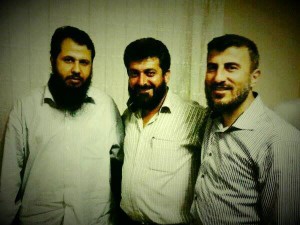
Zahran Alloush, Hassan Abboud and Isa al-Sheikh, the leaders of the Islam Brigade (now Islamic Front), Ahrar al-Sham and Suqour al-Islam respectively, taken upon their release by the regime from the Saidnaya prison in mid-2011.
The most famous story is perhaps that of Zahran ‘Alloush, Hassan Abboud and Isa al-Sheikh, three leaders of three main Islamist factions fighting in Syria today (the Islam Brigade, which later became the Islam Army and then the Islamic Front; Ahrar al-Sham and Suqour al-Islam respectively). A rare picture of the three ‘friends’ standing together, taken upon their release from the Saidnaya prison in mid-2011, was published online in late 2013.207 All three were released from prison following a presidential ‘amnesty’ on 31 May 2011.208 Around the same time, Abu Mohammad al-Fateh al-Jolani, the leader of the Syrian offshoot of Al-Qaeda, al-Nusra Front, also returned from Iraq. They all went on to form different Islamist groups that became some of the largest and most heavily armed and supported factions fighting against the regime in Syria.
Together with these leaders, hundreds of Islamist extremists who had been held in Syrian prisons (many of them were arrested upon their return from ‘jihad’ in Iraq and Lebanon) were also released, particularly from Saidnaya, only to resume their ‘jihad’ in Syria.209 A Syrian activist who was released from Saidnaya at the same time was quoted by The Telegraph in January 2014 saying: “There was no explanation for the release of the jihadis. I saw some of them being paraded on Syrian state television, accused of being Jabhat al-Nusra and planting car bombs. This was impossible, as they had been in prison with me at the time the regime said the bombs were planted. [The regime] was using them to promote [its] argument that the revolution was made of extremists.”210 Meanwhile, so many other political prisoners (leftist, secular, civil society activists, etc.) were kept in incarceration or killed under torture.
In July 2012, The Sunday Telegraph published an interview with the former Syrian ambassador to Iraq, who was the most prominent regime defector at the time. Nawaf al-Fares said jihadist units that he himself had helped send into Iraq to fight US forces were now “immolating themselves in Syria, at the behest of the regime.” One such action, he claimed, was a double suicide bomb outside the military intelligence complex in al-Qazzaz in Damascus in May 2012, in which 55 people were killed and 370 wounded. “I know for certain that not a single serving intelligence official was harmed during that explosion, as the whole office had been evacuated 15 minutes beforehand,” he said. “All the victims were passers-by instead. All these major explosions have been perpetrated by al-Qaeda through cooperation with the security forces.”211
Al-Fares also claimed that he personally knew of several Syrian government “liaison officers” who still dealt with al-Qaeda. “Al-Qaeda would not carry out activities without the knowledge of the regime,” he said. “The Syrian government would like to use al-Qaeda as a bargaining chip with the West – to say: ‘it is either them or us’.”212
Similar allegations were made by another significant regime defector in July 2013. Afaq Ahmad, the former right-hand man of General Jamil Hasan, the head of Syria’s Air Force Intelligence and one of Bashar al-Assad’s most brutal and trusted henchmen, defected after regime forces arrested and murdered 13-year-old Hamza al-Khatib in 2011, in an infamous crime that became one of the early iconic symbols of the regime’s brutal response to the popular protests. In an interview with a Syrian opposition website, Ahmad said the mukhabarat (intelligence services) had infiltrated jihadist and non-jihadist rebel groups in Syria up to the command level.213
The jihadist groups and brigades were very useful for the regime because they provided a justification for the regime’s insistence on a military solution, and provided it with legitimacy under the pretext of the war on terror… These groups did not cross the red lines that were agreed on by the regime and these groups’ sponsors. This included the regime turning a blind eye to the killing of some Alawis and Druze in order to push them [the minorities] to rally around the regime and hold on to it.
And the game went far beyond Syria’s frontiers. In February 2014, the US Treasury released a new list of sanctions targeting companies and persons it accused of breaching the international sanctions against Iran.214 Like previous editions, the list included companies and people facilitating the arming of the Syrian regime and Iran’s nuclear programme. The new addition this time was the inclusion of one of al-Qaeda’s key operators who had been raising funds and recruiting fighters for the Syrian regime’s ostensible enemy number one, al-Qaeda. And he had been doing so from inside Iran.
The new sanctions targeted “a key Iran-based al-Qa’ida facilitator who supports al-Qa’ida’s vital facilitation network in Iran, that operates there with the knowledge of Iranian authorities,” the Treasury said in a press release.215 Olimzhon Adkhamovich Sadikov, also known as Jafar al-Uzbeki and Jafar Muidinov, is an Uzbek national who is based in Mashhad, Iran, near the border with Afghanistan. His network, according to the Treasury, has been using Iran as a transit point for moving funds and foreign fighters through Turkey to Jabhat al-Nusra in Syria. Al-Uzbeki also facilitated the travel of numerous al-Qaeda extremists in and out of Pakistan and Afghanistan by obtaining Iranian visas and passports for them. All this was apparently done “with the knowledge of the Iranian authorities.”
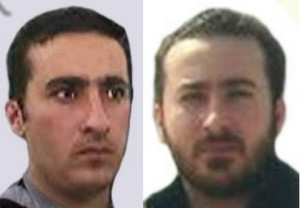
Ezedin Abdel Aziz Khalil, aka Yasin al-Suri, the head of the al-Qaeda network in Iran, according to the US Treasury Department.
Back in July 2011, the US Treasury had added Ezedin Abdel Aziz Khalil, also known as Yasin al-Suri, to its Iran sanctions list. In October 2012, it also targeted Adel Radi Saqr al-Wahabi al-Harbi. The first is said to be the head of the al-Qaeda network in Iran, and the second his deputy. The US government designated a $17 million award for any information leading to their location. Yasin al-Suri, a Syrian national, had been temporarily detained in Iran in 2011 but was later released. As a member of the so-called Islamic Jihad Union, Jafar al-Uzbeki was an associate of Yasin al-Suri and helped him raise funds for his Iran-based activities. Among other things, his network facilitated the transfer of funds from Gulf-based donors to various al-Qaeda groups in Syria, including Jabhat al-Nusrah.216
In February 2012, the Treasury also targeted the Iranian Ministry of Intelligence and Security (MOIS) for “its support to terrorist groups, including al-Qa’ida.”217 “MOIS has facilitated the movement of al-Qa’ida operatives in Iran,” the department said, “and provided them with documents, identification cards, and passports. MOIS also provided money and weapons to al-Qa’ida in Iraq (AQI).” Later that year, AQI would become the Islamic State in Iraq and Sham (ISIS), also known as the Islamic State in Iraq and the Levant (ISIL) and dubbed by Syrians as Da’esh, a mock name derived from the group’s name’s initials in Arabic.218
One would imagine that the US sanctions are decided following extensive research and reliable intelligence, not on the basis of fabricated or speculative media reports. So it is safe, we think, to assume that the information above is reliable and is not just part of a psychological warfare. Supporting both sides of a conflict is an old war tactic. Indeed, the Iranian regime’s support for and facilitation of al-Qaeda’s activities is nothing new – it dates back at least to the US embassy bombings in Kenya and Tanzania in 1998.219 Over the past two decades, the Iranian regime has also allowed many al-Qaeda operatives “a degree of freedom” in Iran as part of its proxy war with the US in Afghanistan and Iraq.220 One Iranian official told NBC News in March 2013 that “no nation has captured as many al-Qaida members as Iran.”221 Many in the US intelligence circles believe that Iran held onto them for use as “bargaining chips.”222 During 2013 and 2014, however, many of them were ‘freed’ by the Iranian authorities and left the country.223
In May 2014, in a strongly worded response to al-Qaeda’s leader Ayman al-Zawahiri’s attempt at reconciliation with ISIS, the latter group’s spokesman Abu Mohammad al-Adnani made a startling admission: al-Qaeda had been ordering its fighters and branches to refrain from attacking Iran so as to preserve the group’s supply network in the country:
The ISIS has kept abiding by the advice and instructions of the sheikhs and figures of jihad. This is why the Islamic State has not attacked the Rawafid [or rejectionists, a term used by Sunni extremists to describe Shia Muslims] in Iran since its establishment, and left the Rawafid safe in Iran, and held back the outrage of its soldiers, despite its ability, then, to turn Iran into bloodbaths. [ISIS] has controlled its anger all these years and endured accusations of collaboration with its worst enemy, Iran, for refraining from targeting it, leaving the Rawafid there to live in safety, acting upon the orders of al-Qaeda to safeguard its interests and supply lines in Iran… Let history record that Iran is indebted to al-Qaeda.224 (emphasis added)
ISIS spokesman Abu Mohammad al-Adnani reveals in a speech in May 2014 that the group has refrained from attacking Iran “acting upon the orders of al-Qaeda to safeguard its interests and supply lines in Iran.”
Internal Syrian state security documents leaked to the media in early 2014 provided further proof that some Islamist armed groups fighting in Syria, particularly ISIS, had been deeply infiltrated by the Syrian regime and had been coordinating with it to some degree. One such document is an alleged letter signed by Colonel Haydar Haydar, the head of the ‘security committee’ in the town of Nabl, near Aleppo, and addressed to Major-General Ali Mamlouk, the head of the National Security Office.225 It reveals arrangements for training and arming hundreds of Shia volunteers, who are said to be “ready to fight on frontlines or join the ranks of Islamist groups.”
“We already have 150 especially trained volunteers,” the letter says, “in addition to 600 who underwent [normal] military training when doing their military service.” A list of the names of over 200 fighters from the predominantly Shia towns of Nabl and Zahraa is enclosed with the letter. “Volunteers keep coming in to defend their homeland,” the letter adds. “We expect their number to reach 2,500 when weapons are made available…. The volunteers are ready to carry out any task assigned to them within these [Islamist] groups, particularly in light of the good results that this method has achieved in our area recently, which is implemented in coordination with the concerned parties in the northern areas.”
Nabl and Zahraa occupy a strategic location because they allow regime forces and militias to control the Aleppo highway. This, according to the letter, enables them to “go in and out of Iraq, in coordination with our allies on the Iraqi side, to move fighters and equipment.” Lifting the opposition’s siege on the two towns was part of the Iranian-brokered deal in Homs in May 2014, which was discussed in detail above.
The leaked letter also reveals that the Syrian regime’s security apparatus had deeply infiltrated and used ISIS. “We now have many members and strong leaders within the [Islamic] State in Iraq and Sham in the northern region in general,” it says. “They can facilitate our new volunteers’ joining the ranks of the group by recommending them and guaranteeing that no suspicions about them are raised.” This, the letter adds, “will guarantee detailed and constant information about the armed men’s movements, their numbers, equipment and plans.”226
The letter then highlights the difficulty that Iraqi pro-regime fighters are facing when joining Islamist groups because of their names and religious sect (Shia). So a number of Syrian ID cards are requested as a solution, in addition to a request that the salaries of the volunteers are raised and that they are provided with all sorts of weapons and vehicles.
Allegations that ISIS fighters captured or killed by the Free Syrian Army (following its official fallout with ISIS in early 2014) possessed Syrian and Iranian IDs and passports have been made by the Syrian opposition before. In February 2014, the National Coalition released a four-page memo entitled “The Islamic State in Iraq and Sham and the Assad regime: from marriage of convenience to real partnership.”227 The memo details evidence of such ‘partnership’ based on confessions of captured ISIS members, testimonies of FSA members and material found at ISIS bases taken by the FSA. The latter allegedly includes Russian passports, Iranian visas and Iranian SIM cards, but the video showing the material referenced in the footnotes seems to have been taken down since.228
That same month (February 2014), the leader of the Islamic Front Zahran Aloush made similar allegations during an interview, claiming that a number of local ISIS commanders that the Front had killed or captured turned out to be Syrian army officers or had travelled to Iran, judging by the Iranian passports and visas found on them.229
In January 2014, Al-Arabiya TV channel aired video footage showing ISIS members detained by the FSA, whom the latter accused of “cooperating with the regime of President Bashar al-Assad and of seeking to divide rebels.”230 One of the detainees is quoted saying: “It happened once that a Syrian regime officer and 11 others defected and drove their vehicle through Masila [north of Raqqa]. We received orders to arrest them and hand them over back to the regime.” Another detainee claimed that the group’s leader in the province of al-Raqqa, known as Abu Anas al-Iraqi, and whose unit apparently specialised in kidnappings, car bombs and targeted assassinations of FSA members, was “financed directly by the regime, through Iran and Iraq.”
The clearest evidence to date of links between ISIS and Jabhat al-Nusra on the one hand and the Syrian and Iranian regimes on the other is perhaps the secret oil deals between the two. In January 2014, The Telegraph published a report, based on Western intelligence sources, claiming that both al-Nusra and ISIS had been selling oil and gas from wells under their control to and through the Syrian regime.231 The report suggests that the regime began “collaborating actively” with these groups in spring 2013. “When Jabhat al-Nusra seized control of Syria’s most lucrative oil fields in the eastern province of Deir al-Zour, it began funding its operations in Syria by selling crude oil, with sums raised in the millions of dollars.” One intelligence source commented: “Assad’s vow to strike terrorism with an iron fist is nothing more than bare-faced hypocrisy. At the same time as peddling a triumphant narrative about the fight against terrorism, his regime has made deals to serve its own interests and ensure its survival.”
The Telegraph report corroborated previous media reports about oil dealings between the Syrian regime and al-Qaeda-affiliated groups. For example, a Reuters report in January 2013 quoted locals in al-Mayadin saying Jabhat al-Nusra had been transporting crude oil in large tankers from the nearby al-Ward oil and gas field to Deir al-Zor, which was under regime control at the time.232 Another report, published in The Guardian in May 2013, claimed al-Nusra had “struck deals” with regime forces to allow the transfer of Deir al-Zor’s crude across the front lines to the Mediterranean coast.233
The article quotes a Syrian fighter from Ahrar al-Sham saying the Syrian regime was paying more than 150 million Syrian pounds (about 2.3 million US dollars) a month to Jabhat al-Nusra to “guarantee oil is kept pumping through two major oil pipelines [to] Banias and Latakia.” “Middlemen trusted by both sides.” he added, “are to facilitate the deal and transfer money to the organisation.”
In April that year, the EU had lifted sanctions on oil exports from rebel-held areas in Syria in order to “aid the opposition,” leading to a scramble for control over wells and pipelines. As a result, open-air refineries were set up and crude oil was being stored in ditches and heated in metal tanks by wood fires, shrouding the area with black smoke and exposing the local inhabitants to the dangers of the thick smog and the frequent explosions.234
And it was not only oil. In a long interview published in Al-Hayat newspaper in April 2014, a Free Army commander claimed ISIS was selling grain to the regime while Syrians were dying of starvation.235 “As the fighting between the Free Army and Daesh [ISIS] intensified,” he said, “the latter struck a deal with the regime to sell it the two-year grain stocks they had put their hands on and had hidden away in Deir al-Zor. They sold a kilo of wheat, maize, lentils or barley for 8 Syrian pounds only, when the actual price, depending on the quality, was between 30 and 100 pounds. The regime would then transport them from Deir al-Zor to the areas under its control.” The commander also claimed that he used to receive information about the convoys transporting the grains and had seen some with his own eyes when attacking them on their way to the coastal area.
Other pieces of evidence of collaboration between ISIS and the regime often cited by Syrians include the fact that, until recently, the regime’s troops and air force had largely avoided clashing with and bombing ISIS bases and strongholds, while continuing to bombard and besiege all other armed factions. And vice versa: while targeting and killing rival opposition activists and leaders, ISIS almost stopped all fighting against the regime around mid-2013.
This has been confirmed by various testimonies. An ISIS defector is quoted in The Telegraph article mentioned above saying: “We were confident that the regime would not bomb us. We always slept soundly in our bases.”236 In the above-mentioned Al-Hayat interview, the Syrian rebel commander also says: “About eight months ago, they [ISIS] completely stopped all fighting with the regime. They would just go and put their hand on any liberated area, and ‘liberate’ the liberated. ISIS is today busy attacking the opposition… they either impose what they want, or threaten [others] with explosions and suicide bombs. That’s how they
controlled the areas liberated from the regime.”237
To sum up, there is abundant evidence that both the Syrian and the Iranian regimes have infiltrated, collaborated and used al-Qaeda-affiliated groups to serve their own interests, either by aiding them and then using them against their opponents, or trading their extensive knowledge of these groups’ networks and figures with Western powers, and even selling them off, in exchange for being allowed to stay in power, or by claiming to be victims of terrorism so as to discredit all their opponents and legitimise their brutal crackdown on them. Syrian opposition leader Burhan Ghalyoun has dubbed this “three-way strategy” as “the business of terrorism.”238
Moreover, the US administration, which has deployed similar strategies in the past, seems to be happy to play along. In June 2014, Anne Barnard of The New York Times tweeted that a US government adviser had told her that fighting ISIS was “not [a] priority” for the US government because ISIS was “useful in tarring all insurgents & framing choice as Assad/ISIS.”239
The events in Syria and Iraq over the past two years seemed to confirm this claim, at least until August 2014, when the UN Security Council adopted a resolution, under the binding Chapter VII of the United Nations Charter, calling on all member states to “act to suppress the flow of foreign fighters, financing and other support to Islamist extremist groups in Iraq and Syria,” namely ISIS and Jabhat al-Nusra.240 The Syrian and Iranian regimes suddenly started to sell themselves to the West as ‘partners’ in combating terrorism (more on this in the ‘Iran’s Vietnam’ chapter).
Notes & References
54 Farnaz Fassihi, ‘Iran said to send troops to bolster Syria’, The Wall Street Journal, 27 August 2012.
55 Stratfor, ‘The Use of Mercenaries in Syria’s Crackdown’, Ocnus.Net, 15 January 2012.
56 ‘Hezbollah shifts tactics, narrative for Syria fight’, AFP, 14 April 2014.
57 ‘Some details on IRGC and HZ presence in Syria – ME1’, The Global Intelligence Files, WikiLeaks, 8 March 2012.
58 Available on YouTube.
59 James Hider and Nate Wright, ‘Assad pays snipers “to murder protesters”’, The Times, 26 January 2012.
60 Najah Mohammad Ali, ‘Hezbollah entered Syria to protect Iranian base’ (in Arabic), Al-Arabiya, 22 January 2012.
61 ‘Evidence grows Iran aiding Syria’s Assad’, UPI, 2 June 2011.
62 Geneive Abdo, ‘How Iran keeps Assad in power in Syria’, Foreign Affairs, 25 August 2011.
63 ‘Hezbollah military commander “killed in Syria”’, BBC, 2 October 2012.
64 ‘Hezbollah held funeral for martyr Ali Nassif in Bawadi’ (in Arabic), Official site of the Islamic Resistance – Lebanon, 1 October 2012.
65 ‘Hezbollah held funeral for martyr Musa Shahimi in Rawdat al-Shahidayn’ (in Arabic), Al-Ahd News, 10 August 2012.
66 ‘Hezbollah’s participation in Syria and the names of its fighters who have died so far’ (in Arabic), Lebanon Files, 27 April 2013.
67 See, for example, this video and this and this.
68 US Department of Treasury, ‘Treasury targets Hizballah for supporting the Assad regime’, 10 August 2012.
69 US Department of State, ‘Briefing on the designation of Hezbollah for supporting the Syrian regime’, 10 August 2012.
70 US Department of Treasury, ‘Treasury designates Hizballah leadership’, 13 September 2012.
71 ‘“They make up their own mind”’, Naame Shaam, 27 January 2014.
72 Samia Nakhoul, ‘Special Report: Hezbollah gambles all in Syria’, Reuters, 26 September 2013.
73 ‘Iran plunged Hezbollah into Syrian war, Tufaili’, Ya Libnan, 3 July 2013.
74 Farnaz Fassihi, Jay Solomon and Sam Dagher, ‘Iranians dial up presence in Syria’, The Wall Street Journal, 16 September 2013.
75 ‘Intercepted radiotransmission – Iran troops in Syria 2013’, YouTube, 8 June 2013.
76 ‘Hezbollah’s participation in Syria’, Lebanon Files, idem.
77 Fadi Shamiyyeh, ‘Not only in Qusayr is Hezbollah fighting’ (in Arabic), Middle East Online, 27 April 2013.
78 ‘Hezbollah fighters, Syrian rebels killed in border fighting’, Al-Arabiya, 17 February 2013.
79 ‘Sayyed Nasrallah: Drone Is Ours, It Won’t Be the Last’, Al-Manar, 1 November 2012. The actual speech is available in English on YouTube (the talk about Syria starts at 22:25).
80 For more on Hezbollah’s involvement in Syria and how it justified it at different stages, see, for example, International Crisis Group, Lebanon’s Hizbollah Turns Eastward to Syria, May 2014.
81 The battle has been well documented and extensively analysed. See, for example, these reports: 1 | 2 | 3 | 4 | 5 | 6 | 7. For an Iranian state view, see, for example, this Press TV documentary about the al-Qusayr battle.
82 Farnaz Fassihi, Jay Solomon and Sam Dagher, ‘Iranians dial up presence in Syria’, The Wall Street Journal, 16 September 2013.
83 Erika Solomon, ‘Syrian army captures strategic border town of Qusair’, Reuters, 5 June 2013.
84 Mona Alami, ‘Hezbollah fighter details ops in Qusayr’, Now, 4 June 2013.
85 ‘Sayyed Nasrallah: As I promised you victory in July, I renew my promise today’, Al-Manar, 29 May 2013.
86 Farnaz Fassihi et. al., ‘Iranians dial up Presence in Syria’, WSJ, idem.
87 See, for example, Anne Barnard and Hwaida Saad, ‘Hezbollah Aids Syrian Military in a Key Battle’, The New York Times, 19 May 2013.
88 Isabel Nassief, The Campaign for Homs and Aleppo, Institute for the Study of War, January 2014.
89 Nicholas Blanford, ‘Hezbollah close to cutting off key route for Syrian rebels, refugees’, The Christian Science Monitor, 14 March 2014.
90 For more on the use of barrel bombs in Aleppo, see, for example, Human Rights Watch, ‘Syria: Unlawful Air Attacks Terrorize Aleppo’, 24 March 2014.
91 For a list of Syria battles involving Hezbollah Lebanon, see this Wikipedia entry.
92 ‘Iranian officers led Syrian regime militias in Homs: defected general’, Al-Arabiya, 13 August 2012.
93 See, for example, the Periodic Reports of the Independent International Commission of Inquiry on the Syrian Arab Republic.
94 Farnaz Fassihi et. al., ‘Iranians dial up presence in Syria’, WSJ, idem.
95 See, for example, ‘Syrian rebels withdraw from Homs, marking key victory for Assad’, The Christian Science Monitor, 7 May 2014.
96 For more details about these two towns, see: ‘Leaked documents confirm Syrian regime’s infiltration of Al-Qaeda offshoot’, Naame Shaam, 1 May 2014.
97 ‘Opposition Coalition accuses government of executing 20 Homs fighters who were evacuated in the truce deal’ (in Arabic), Al-Quds Al-Arabi, 8 June 2014.
98 Brooklyn Middleton, ‘Homs truce underscores high degree of Iranian involvement’, Al-Arabiya, 9 May 2014.
99 Ibrahim Himeidi, ‘A permanent office for Iranian mediator in al-Wa’r district, the last rebel stronghold in Homs’ (in Arabic), Al-Hayat, 7 June 2014.
100 ‘Opposition: Homs truce confirms Assad’s subordination to Iran and his exclusive sponsorship of terrorism’ (in Arabic), CNN Arabic, 5 May 2014.
101 Maria Abi-Habib, ‘Syrian Government, Rebels Agree to Cease Fire in Homs’, The Wall Street Journal, 2 May 2014.
102 For a detailed account of the battle and why Hezbollah won it, see: ‘Why Yabroud fell to al-Assad and Hezbollah forces’, Naame Shaam, 18 March 2014.
103 ‘Hezbollah sends 2,000 fighters to Yabroud… and rebels resist’ (in Arabic), Orient News, 19 February 2014.
104 ‘Yabroud battles intensify… and news of Badr Legion fighters sent to support regime forces in the battle’ (in Arabic), Al-Sharq al-Awsat, 3 March 2014.
105 See, for example, this video and this and this.
106 See, for example, this video and this one, in which one can clearly hear a distinct Lebanese accent.
107 ‘Qassem: Hezbollah will defeat takfiri plot, achievements to appear soon’, Al-Manar, 07 February 2014. For more details on this issue, see: ‘Hezbollah uses Lebanon terrorist attacks to justify invasion of Yabroud, Syria’, Naame Shaam, 17 February 2014. See also this Naame Shaam report.
108 ‘Hezbollah shifts tactics, narrative for Syria fight’, AFP, 14 April 2014.
109 ‘The Syrian regular army against Hezbollah?’ (in Arabic), Lebanon Debate, 2 February 2014, available. For an English translation, see here.
110 e.g. Mona Alami, idem.; ‘Exclusive interview with a Hezbollah fighter’ (in Arabic), Now, 15 November 2013.
111 Mona Alami, idem.
112 For a detailed report about the massacre and Hezbollah’s involvement, see: ‘Hezbollah accused of another massacre near Damascus, treating dead with “utmost disrespect”’, Naame Shaam, 5 March 2014.
113 Available on YouTube.
114 ‘Scenes of the moment when armed groups are ambushed by Syrian army in Eastern Ghouta’ (in Arabic), Al-Manar, 26 February 2014.
115 Action Group for the Palestinians of Syria, Report on the conditions of Palestinian refugees in Syria, March 2014.
116 Terrence McCoy, ‘Thousands starving on outskirts of Damascus; situation “unprecedented in living memory,” U.N. says’, The Washington Post, 21 April 2014.
117 Available on YouTube or here.
118 ‘Khamenei asked Sistani and Haeri to issue ‘jihad against takfiris fatwa’ to save al-Assad’ (in Arabic), Al-Seyasa, 7 August 2012.
119 Ali Mamouri, ‘Shiite seminaries divided on fatwas for Syrian jihad’, Al-Monitor, 29 July 2013.
120 Qassim Abdul-Zahra, ‘Prominent Shiite cleric backs fighting in Syria’, AP, 15 Decemeber 2013.
121 ‘Publications’, The official website of Ayatollah Kazem al-Haeri.
122 Ali Mamouri, ‘Shiite seminaries divided on fatwas for Syrian jihad’, idem.
123 ‘Saudi Wahhabis call for the destruction of Shia shrine in Syria’, Tehran Times, 21 July 2012.
124 See, for example, this report (in Arabic) for how the alleged video was being described: “A video was published on YouTube which contains statements by persons claiming to belong to the Free Syrian Army calling for the destruction of the shrine of Sayyida Zaynab, the daughter of Imam Ali, in the suburbs of Damascus, as well as other shrines and graves belonging to the family of the Prophet.”
125 See this recording.
126 See, for example, this speech by Yasser al-Habib, in which he only talks about the Wisal news item.
127 ‘Car bomb damages major Shiite shrine in Syria’, Associated Press, 14 June 2012.
128 Ibid.
129 ‘Syrian troops retake Sayyida Zainab neighborhood from rebels’, Press TV, 1 August 2012. See also this video of one of the massacres committed by regime forces in Sayyida Zaynab at the time, and this report about the suffering among civilians after regime forces took over the area.
130 These and other Shia slogans refer to the battle of Karbalaa, more than 1,400 years ago, between the Damascus-based Umayyads and the followers of Imam Ali’s son Hossein, who came to be known as Shia, over the right to caliphate. Hossein was killed in the battle and his sister Zaynab was taken captive to Damascus.
131 Visser Reider, ‘Religious allegiances among pro-Iranian special groups in Iraq’, CTC Sentinel, 26 September 2011.
132 ‘Prominent [Shia] authority in Najaf: Those who go to fight in Syria disobey our orders’ (in Arabic), Al-Sharq al-Awsat, 21 July 2013. See also: ‘War in Syria widens divide between Shia religious authorities in Iraq and Iran’ (in Arabic), Al-Quds Al-Arabi, 21 July 2013.
133 ‘Registration for defenders of holy shrines: volunteers for defending Sayyida Zeynab’ (in Persian), Behesht, 3 June 2013.
134 ‘Religious seminaries demand that government intervenes to protect religious shrines in Syria from violent acts’ (in Arabic), Sawt al-Iraq, 27 July 2012.
135 ‘Conference in support of Sayyida Zaynab, a popular delegation to head from Karbalaa to Damascus’ (in Arabic), Buratha News, 28 July 2012.
136 See, for example, Mona Mahmood and Martin Chulov, ‘Syrian war widens Sunni-Shia schism as foreign jihadis join fight for shrines’, The Guardian, 4 June 2013.
137 See, for example, European Council on Foreign Relations, ‘Syria: the view from Iraq’, 14 June 2013.
138 ‘Syrian troops retake Sayyida Zainab’, Press TV, idem. See also: ‘Syrian popular committees to protect Sayyida Zaynab shrine’ (in Arabic), Al-Mayadeen, 13 March 2013; Jamal al-Gharbi, ‘In Sayyida Zaynab district: Visitors and popular committees and protection units’, Al-Akhbar, 28 March 2013.
139 See, for example, this report.
140 ‘Hezbollah Denounces Terrorist Crimes against Holy Sites in Syria’, Al-Manar, 27 March 2014, available: .
141 Syrian Network for Human Rights, Syria Without Mosques, 5 March 2014.
142 ‘Hezbollah denounces destruction of (Shia) holy sites in Syria, ignores thousands of mosques destroyed by the regime’, Naame Shaam, 5 April 2014.
143 Phillip Smyth, ‘From Karbala to Sayyida Zaynab: Iraqi Fighters in Syria’s Shi`a Militias’, 27 August 2013, CTC Sentinel. See also: Phillip Smyth, ‘From Najaf to Damascus and Onto Baghdad: Iraq’s Liwa Abu Fadl al-Abbas’, Jihadology, 18 June 2014.
144 ‘Abu al-Fadl al-Abbas, a sectarian title in the Syrian tragedy’ (in Arabic), Al-Jazeera, 19 November 2013.
145 Suadad al-Salhy, ‘Iraqi Shi’ite militants fight for Syria’s Assad’, Reuters, 16 October 2012.
146 For more details on the origins and early activities of the group, see: Phillip Smyth, ‘What is the Liwa’a Abu Fadl al-Abbas (LAFA)?: Assessing Syria’s Shia “International Brigade” through their social media presence’, Jihadology, 15 May 2013.
147 Suadad al-Salhy, ‘Iraqi Shi’ites flock to Assad’s side as sectarian split widens’, Reuters, 19 June 2013.
148 See, for example, this video and this and this. For an overview of the group’s militant songs, see: Phillip Smyth, ‘The Songs of Liwa’a Abu Fadl al-Abbas: Militant Iraqi Shia Music & Syria’, Jihadology, 3 July 2013.
149 Nicholas Blanford, ‘Video appears to show Hezbollah and Iraqi Shiites fighting in Syria’, The Christian Science Monitor, 18 January 2013.
150 Mona Mahmood and Martin Chulov, ‘Syrian war widens Sunni-Shia schism as foreign jihadis join fight for shrines’,
The Guardian, 4 June 2013.
151 For a brief history of the group’s origin, see Sam Wyer, The Resurgence of Asa’ib Ahl Al-Haq, Institute for the Study of War, Middle East Security Report 7, December 2012.
152 Ibid.
153 See the unit’s statements.
154 See, for example, this video and this and this.
155 See, for example, this video and this one. For a collection of Kafeel Zaynab videos and pictures, see: Phillip Smyth, ‘Asa’ib Ahl al-Haq’s Liwa’a Kafeel Zaynab’, Jihadology, 14 August 2013.
156 Martin Chulov, ‘Controlled by Iran, the deadly militia recruiting Iraq’s men to die in Syria’, The Guardian, 12 March 2014.
157 See, for example, Rabiah Jamal, ‘Iraq’s Kataeb Hezbollah announces involvement in Syria’, Now, 7 April 2013.
158 Sam Dagher, ‘Fighters, flowing to Syria, guard Shiites’, The Wall Street Journal, 23 May 2013.
159 Adam Schreck and Qassim Abdul-Zahra, ‘Asaib Ahl Al-Haq, Iraq Shiite militia, will reportedly lay down arms’, Huffington Post, 6 January 2012.
160 Suadad al-Salhy, ‘Iraqi Shi’ite militants fight for Syria’s Assad’, idem.
161 Phillip Smyth, ‘Breaking Badr, The new season: Confirmation of the Badr Organization’s involvement in Syria’, Jihadology, 12 August 2013.
162 Phillip Smyth, ‘The Badr Organization’s Syrian expeditionary force: Quwet al-Shahid Muhammed Baqir al-Sadr’, Jihadology, 18 October 2013.
163 For an overview of Iranian-backed Iraqi militias fighting in Syria, see, for example: K. Gilbert, The Rise of Shi’ite Militias and the Post-Arab Spring Sectarian Threat, International Institute for Counter-Terrorism, October 2013; Syrian Network for Human Rights, The Fighting Shiite Militias in Syria, July 2014 (the original Arabic is available here); Wasim Nasr, ‘Who are the Iraqi Shia fighters in Syria?’ (in Arabic), France 24, 13 December 2013.
164 Suadad al-Salhy, ‘Iraqi Shi’ites flock to Assad’s side as sectarian split widens’, Reuters, idem.
165 For a round-up of Iraqi militants killed in Syria in 2013, see this three-part collection by Phillip Smyth on Jihadology: Part 1; Part 2; Part 3.
166 Jeremy Bowen, ‘The fearsome Iraqi militia vowing to vanquish Isis’, BBC, 7 July 2014.
167 Qassim Abdul-Zahra and Adam Schreck, ‘Iraqi Shiites brace for violence amid Syria fears’, Associated Press, 25 October 2012.
168 Mona Mahmood and Martin Chulov, ‘Syrian war widens Sunni-Shia schism as foreign jihadis join fight for shrines’, The Guardian, 4 June 2013.
169 Ibid.
170 Yasir Ghazi and Tim Arango, ‘Iraqi Sects Join Battle in Syria on Both Sides’, The New York Times, 27 October 2012.
171 Ibid.
172 Mona Mahmood and Martin Chulov, idem.
173 ‘Confessions of Iraqi mercenaries captured by the rebels in the suburbs of Damascus’ (in Arabic), YouTube, 31 December 2013.
174 Ibid.
175 e.g. in Eastern Ghouta; in Western Aleppo; in al-Rashdin, Aleppo.
176 ‘Confirming what Al-Tahrir had previously disclosed: An ‘Asa’ib Ahl al-Haq member is killed in Syrian Hama’ (in Arabic), Al-Tahrir News, 27 May 2012.
177 ‘Iraqi militia given Aleppo military academy to use as its HQ’, Naame Shaam, 24 March 2014.
178 Available on YouTube.
179 Information and pictures obtained by the authors from various Syrian activists and citizen-journalists in Damascus.
180 Mona Mahmood and Martin Chulov, idem.
181 Suadad al-Salhy, ‘Iraqi Shi’ites flock to Assad’s side as sectarian split widens’, idem.
182 Maria Abi-Habib, ‘Shiite militias decamping from Syria to fight in Iraq’, The Wall Street Journal, 17 June 2014.
183 Ibid. See also: ‘Hezbollah mobilizes to defend Shiite shrines in Syria’, Now, 12 June 2014.
184 See, for example, Joanna Paraszczuk and Scott Lucas, ‘Regime Mass Killing of Civilians in Nabk in Damascus Province?’, EA WorldView, 7 December 2013.
185 Syrian Network for Human Rights, The Major Massacres Committed by Syrian Government Forces Against Civilian Citizens During 2013 (in Arabic), December 2013. See also the detailed reports by SN4HR about each individual massacres in al-Nabek, e.g. this one and this one.
186 Center for Documentation of Violations in Syria, ‘Nabek martyrs list’.
187 Some pictures are available here and some video footage here and here.
188 Syrian Network for Human Rights, ‘Military campaign on town of al-Thiyabiyya in suburbs of Damascus bears marks of sectarian ethnic cleansing’ (in Arabic), 10 September 2013.
189 ‘Afghan refugee kidnapped by FSA in Syria’, YouTube, 30 October 2012.
190 Meena Haseeb, ‘Afghans involvement in Syria war to be investigated: Mosazai’, Khaama Press, 8 April 2013, available: .
191 e.g. ‘Saraya Tali’at al-Khrasani, a new Shia group fighting alongside al-Assad’ (in Arabic), Orient, 9 January 2014. See also also the group’s official Facebook page.
192 Farnaz Fassihi, ‘Iran pays Afghans to fight for Assad’, The Wall Street Journal, 22 May 2014.
193 Farnaz Fassihi and Ehsanullah Amiri, ‘Afghans condemn Iran over recruiting refugees to fight in Syria’, The Wall Street Journal, 21 May 2014.
194 Ershad Alijani and Andrew Hilliar, ‘Afghan migrants offered $500 by Iran to fight for Syrian regime’, France 24, 04 June 2014.
195 See, for example, ‘An Afghan version of Hezbollah in Syria’ (in Arabic), Erem News, 8 June 2014. See also: ‘Afghan fighters join al-Assad forces for $500 a month’ (in Arabic), Al-Arabiya, 7 June 2014.
196 ‘First African martyr defending Sayyida Zaynab shrine’ (in Persian), Ahlul-Bayt News Agency, 27 July 2013. For details in English, see: Phillip Smyth, ‘Fighters from exotic locales in Syria’s Shia militias’, Jihadology, 30 July 2013.
197 Amir Abdallah, ‘URGENT – 30,000 Indians volunteer to fight in Iraq to defend Shia shrines’, Iraqi News, 27 June 2014.
198 See, for example, Saud Al-Sarhan, ‘From Qusair to Yabrud: Shiite foreign fighters in Syria’, Al-Monitor, 6 March 2014.
199 Riyad Qahwaji, ‘40,000 foreign Shiites fighting in Syria: A transnational army led by the [Iranian] Revolutionary Guards’ (in Arabic), Al-Hayat, 5 February 2014.
200 Ibid.
201 See, for example, Will Fulton, Joseph Holliday and Sam Wyer, Iranian Strategy in Syria, AEI’s Critical Threats Project and Institute for the Study of War, May 2013; K. Gilbert, The Rise of Shi’ite Militias and the Post-Arab Spring Sectarian Threat, International Institute for Counter-Terrorism, October 2013.
202 Leila Shrooms, ‘Syria: Who are Assad’s fascist supporters?’, Tahrir ICN, 11 December 2013.
203 ‘Syria: The Greek Nationalist Socialists fighting alongside Asaad’s regime are far more dangerous than Golden Dawn’, Glykosymoritis, 28 September 2013. The original interview in Greek can be found here.
204 For more details, see: Germano Monti, ‘A red-brown alliance for Syria’, Qantara, 14 April 2014.
205 Leila Shrooms, idem.
206 ‘European fascists fighting in Syria alongside regime forces, Sepah Pasdaran and Hezbollah’, Naame Shaam, 11 February 2014.
207 Bassel al-Junaidy, ‘The tale of “the friends of Saidnaya”: the strongest three men in Syria’, Republic Group for Studies, 23 October 2013.
208 Ibid.
209 For more on the ‘Saidnaya experiment’ (making and preparing jihadists inside the infamous prison), see: Firas Sa’d, ‘On the ‘Saidnaya experiment and its repercussions for the Syrian revolution: Organising Islamists as a first rehearsal for a civil conflict’ (in Arabic), Republic Group for Studies, 26 December 2013. See also: Rania Abouzeid, ‘The Jihad next door: The Syrian roots of Iraq’s newest civil war’, Politico, 23 June 2014; Mohammed Habash, ‘Radicals are Assad’s best friends’, The National, 1 January 2014.
210 Ruth Sherlock and Richard Spencer, ‘Syria’s Assad accused of boosting al-Qaeda with secret oil deals’, The Telegraph, 20 January 2014.
211 Ruth Sherlock, ‘Exclusive interview: Why I defected from Bashar al-Assad’s regime, by former diplomat Nawaf Fares’, The Sunday Telegraph, 14 Jul 2012.
212 Ibid.
213 Riyad Khaled, ‘Interview with Afaq Ahmad: On the Alawites, the infiltration of Islamist groups and the assassination of Bashar al-Assad’ (in Arabic), All4Syria, 27 July 2013. For English, see: Michael Weiss, ‘Assad’s no enemy of al-Qaeda’, Now, 31 July 2013.
214 US Department of the Tresury, ‘Treasury targets networks linked to Iran’, 6 February 2014.
215 Ibid.
216 Ibid.
217 US Department of the Tresury, ‘Treasury designates Iranian Ministry of Intellligence and Security for human rights abuses and support for terrorism’, 16 February 2012.
218 See: ‘After ‘Daesh’, Syrians invent new mocking name for Hezbollah Lebanon: Halesh’, Naame Shaam, 25 February 2014.
219 ‘Judge finds Sudan and Iran liable for 1998 embassy bombings’, Legal Times, 1 December 2011.
220 Michael B Kelley, ‘Why is Iran letting a top al-Qaeda operative pump fighters and cash into Syria?’, Business Insider, 1 February 2014. See also: Dania Saadi, ‘Iran official admits to aiding Zarqawi in Iraq, Al-Awsat says’, Bloomberg, 11 August 2004.
221 Robert Windrem, ‘Exclusive: Iran was holding bin Laden son-in-law Abu Ghaith, US officials say’, NBC News, 7 March 2013.
222 See, for example, Jason Burke, ‘What is the relationship between Iran and al-Qaida?’, The Guardian, 23 April 2013; Peter Bergen, ‘Strange bedfellows — Iran and al Qaeda’, CNN, 11 March 2013.
223 See, for example, Adam Goldman, ‘Senior al-Qaeda figure leaves Iran amid a series of departures by terrorist suspects’, The Washington Post, 14 February 2014.
224 ‘Abu Mohammad al-Adnani, ISIS’s spokesman: Iran is indebted to al-Qaeda’, Janoubia, 14 May 2014. For English, see: Bill Roggio, ‘“Iran owes al Qaeda invaluably,” ISIS spokesman says’, Long War Journal, 12 May 2014.
225 ‘A leaked document addressed to Ali Mamlouk reveals links with ISIS fighters’ (in Arabic), Al-Sharq al-Awsat, 4 April 2014. For an English translation and commentary, see here. The documents were originally published by a little-known website called Damascus Leaks.
226 Ibid.
227 Syrian Opposition Coalition – Geneva Media Unit, ‘Memo: ISIS and the Assad regime: From marriage of convenience to partnership’, 10 February 2014. The original Arabic is available here.
228 This is the original link.
229 ‘Alloush: [ISIS] leader Hajji Bakir carries an Iranian passport’ (in Arabic), Suriya al-Ghad, 26 February 2014.
230 ‘Al-Qaeda detainees reveal ties with Assad’, Al-Arabiya, 20 January 2014.
231 Ruth Sherlock and Richard Spencer, ‘Syria’s Assad accused of boosting al-Qaeda with secret oil deals’, The Telegraph, 20 January 2014.
232 ‘Eastern Syrian town lives under al Qaeda rules’, Reuters, 30 January 2013.
233 Julian Borger and Mona Mahmood, ‘EU decision to lift Syrian oil sanctions boosts jihadist groups’, The Guardian, 19 May 2013.
234 Ibid.
235 Faysal Abdul-Karim, ‘Abu Uday: Daesh is selling grain to the regime while people starve’ (in Arabic), Al-Hayat, 28 April 2014.
236 Ruth Sherlock and Richard Spencer, idem.
237 Faysal Abdul-Karim, idem.
238 Burhan Ghalyoun, ‘The business of terrorism… Iran, Al-Maliki, and Al-Assad’ (in Arabic), Al-Araby al-Jadeed, 19 June 2014. And English translation is available here.
239 Anne Barnard, Tweet on 12 June 2014, 4:12 PM.
240 UN Security Council, ‘Security Council adopts Resolution 2170 (2014) condemning gross, widespread abuse of human rights by extremist groups in Iraq, Syria’, 15 August 2014.
 English
English  فارسی
فارسی  العربية
العربية 